Is it possible to restore an old golf course while preparing it to host a future major championship? Gil Hanse, for one, is trying.
His firm, Hanse Golf Course Design, has shown itself capable of both restoring designs from the “Golden Age” of golf architecture and getting courses ready for big-time tournaments. Within the next five years, the U.S. Open will sample Hanse’s restoration work at Winged Foot and Los Angeles CC. The PGA of America has tapped him to build its new East Course at PGA Frisco, and in the next decade the PGA Championship will visit three of his restorations: Aronimink (2026), Baltusrol (2029), and—possibly in 2025 but more likely in 2030—Southern Hills Country Club in Tulsa, Oklahoma.
Southern Hills, a 1936 Perry Maxwell design, reopened for member play earlier this summer after a 10-month, $11-million makeover. Hanse’s work on the course occupies a kind of philosophical middle ground. On the one hand, he took Southern Hills back to its roots. The bunkers, greens, and hole corridors strongly resemble Maxwell’s original creations. On the other hand, as a future venue for majors, it is very much a modern championship test.
How Hanse negotiated this tension may offer a glimpse into the future of high-profile golf architecture. Today, as the driving-distance gap between elite and average golfers continues to widen, many of the world’s great courses are struggling to respect their origins while remaining viable championship hosts. The new Southern Hills attempts to do just that.
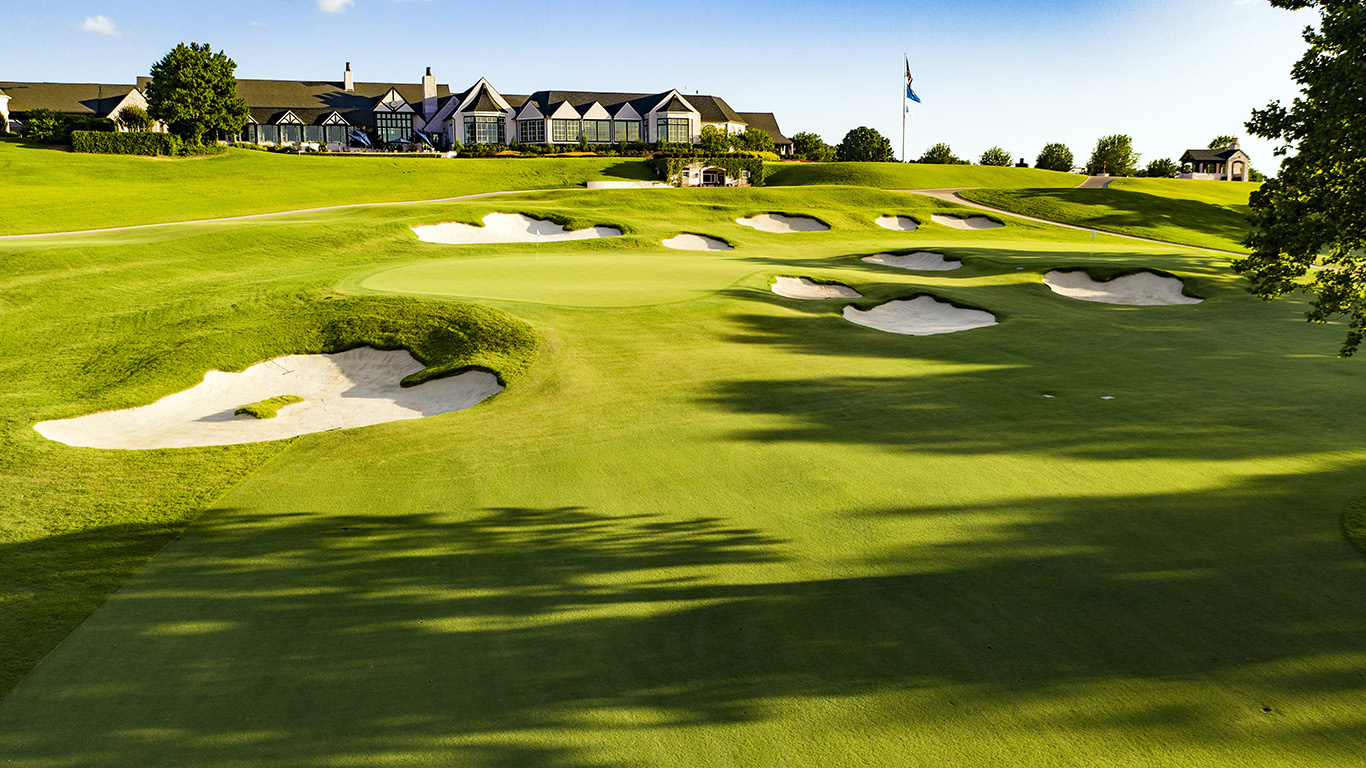
The 18th (left) and 9th (right) greens below the clubhouse at the restored Southern Hills Country Club
A championship history
In the mid-1930s, the Depression battered Oklahoma. Oil prices plummeted, thousands lost their jobs, and a series of dust storms ravaged the region’s agriculture. So it was remarkable that in 1934 a group of citizens in Tulsa managed to raise $140,000 for a new country club. A local oil baron, Waite Phillips, donated a rolling tract of land south of the city and urged investors to hire the region’s finest golf architect, Perry Maxwell.
Maxwell directed a large crew consisting primarily of Works Progress Administration labor. They stayed in tents on the site and built the course for about $113,000. “Technically speaking,” historian Chris Clouser wrote in The Midwest Associate, “the course at Southern Hills is the closest product to the ideals of what Maxwell had in mind for golf course design. He moved little land and was cost effective in his work and created a strategically sound course using the attributes of the land to mold the golf holes.”
From the day it opened in 1936, Southern Hills aspired to host national championships. Soon after the end of World War II, the club began racking up significant tournaments, including the 1946 U.S. Women’s Amateur and the 1953 U.S. Junior Championship.
In 1958, the U.S. Open came to Southern Hills. The year prior, Robert Trent Jones had put the course through his now-familiar “Open Doctor” treatment. He pushed back tees, pulled in rough lines, and added bunkers. Par was adjusted from 71 to 70. In an article for the tournament program, RTJ described these adjustments and praised the course’s brawn.
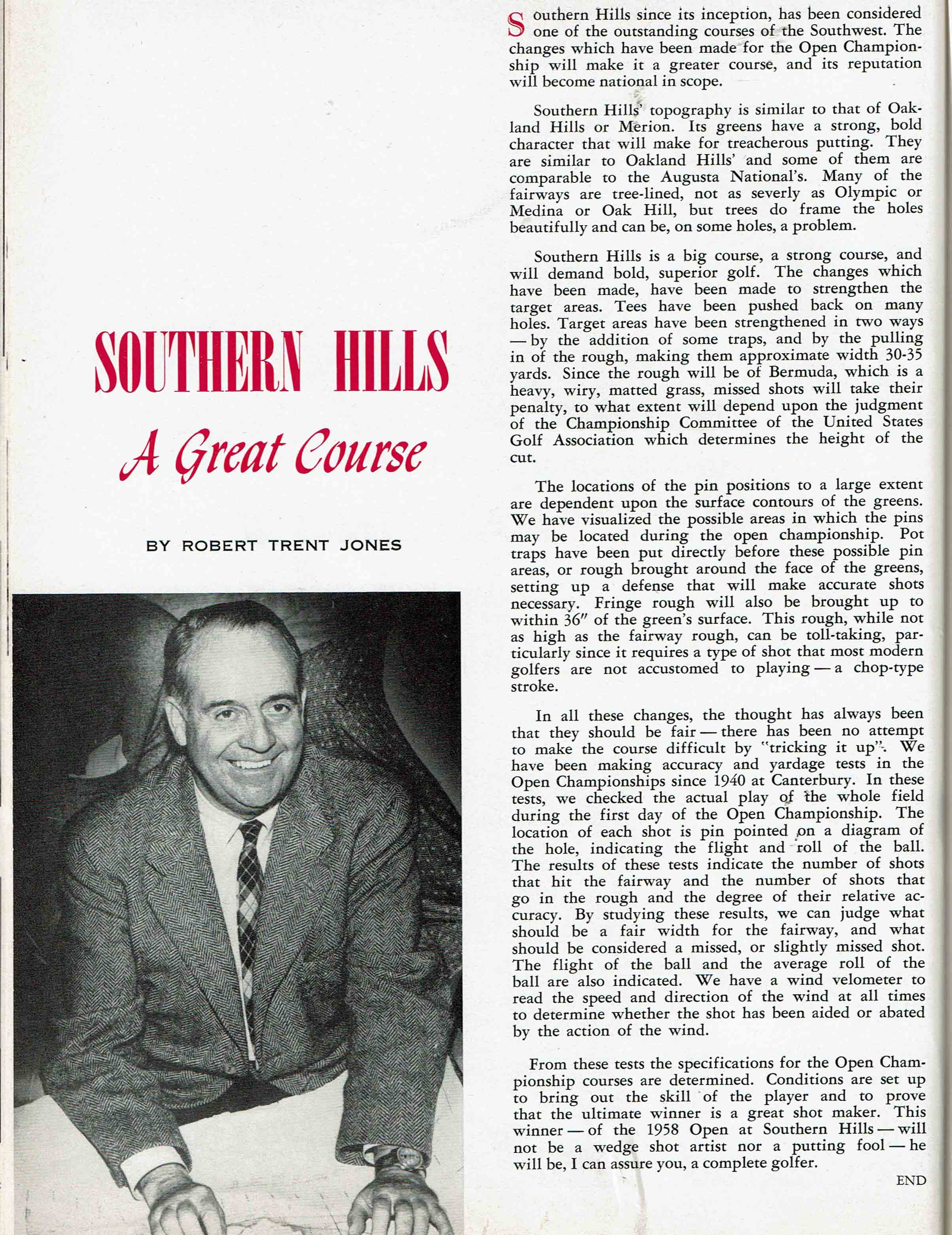
Research credit: Clyde Chrisman
Ultimately, though, Mother Nature had the last word. During the tournament, temperatures exceeded 90 degrees, and newspapers began using the phrase “the Blast Furnace Open.” Oklahoman Tommy Bolt prevailed at +3, four shots clear of the runner-up, an exceptionally fit 22-year-old from South Africa named Gary Player.
By the time of the Blast Furnace Open, Southern Hills had drifted away from its 1936 design, and it kept drifting in the ensuing decades. Tree planting narrowed and enclosed the holes. Rough replaced short grass. The jagged-edged bunkers took on simple saucer shapes. While the course’s bones—its routing, topography, and green sites—remained intact, its original aesthetic character disappeared, as did the strategic nuances of Maxwell’s holes.
-
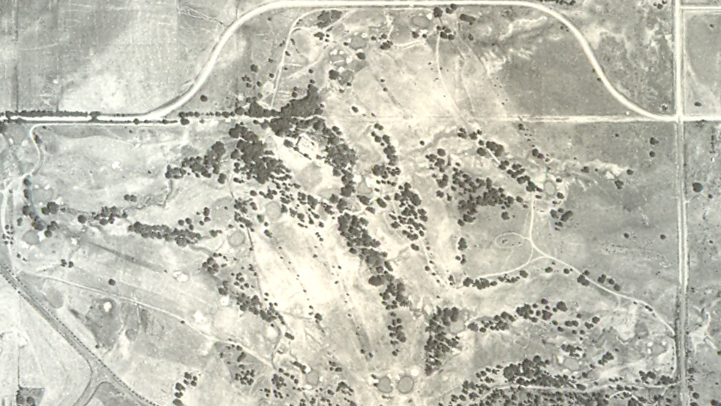
Southern Hills in 1943 (OKMAPS.org)
-
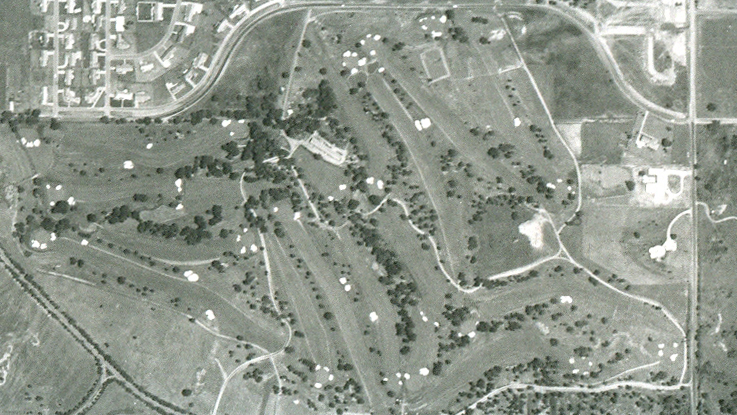
Southern Hills in 1958 (OKMAPS.org)
-
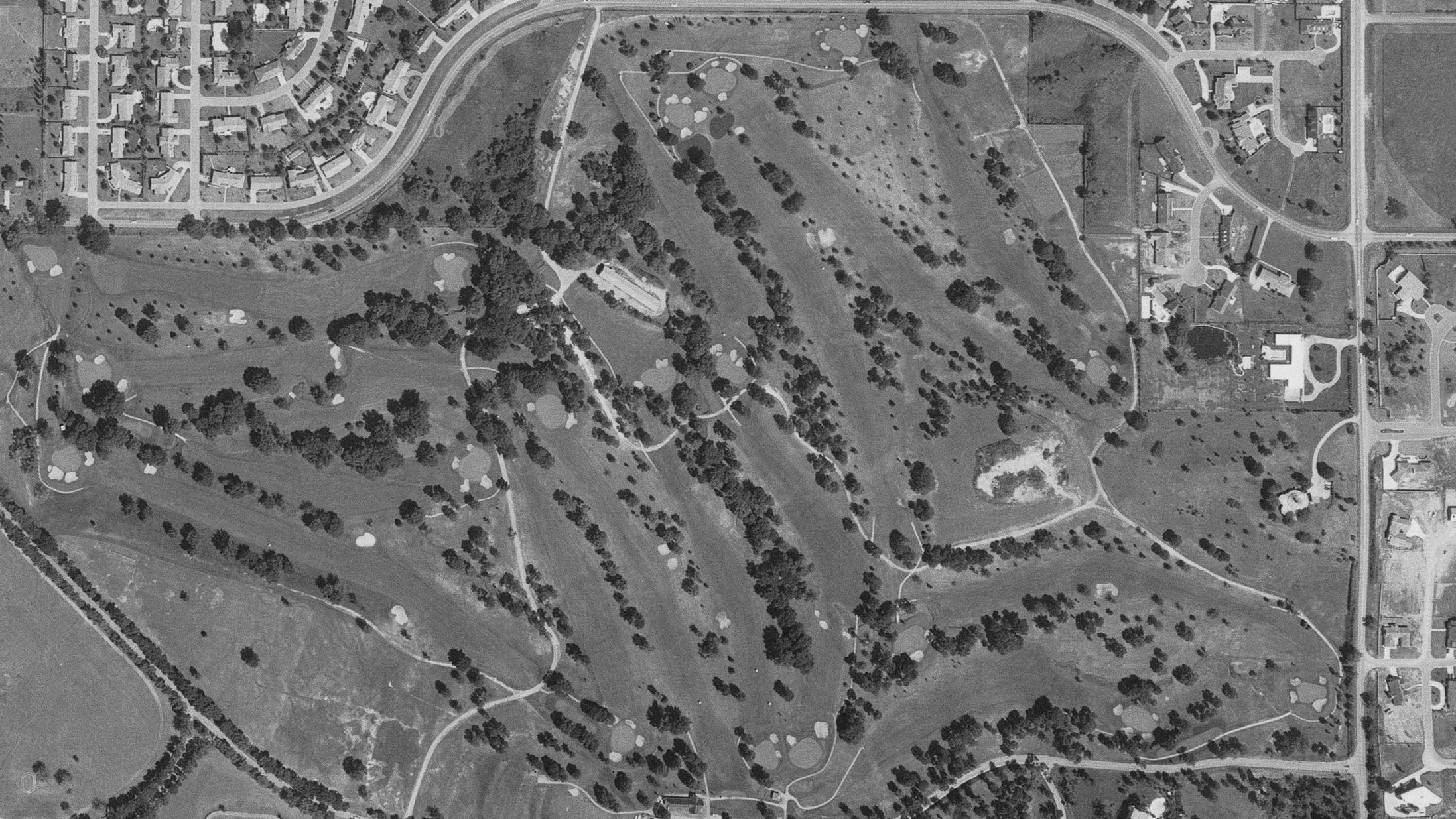
Southern Hills in 1967 (USGS)
-
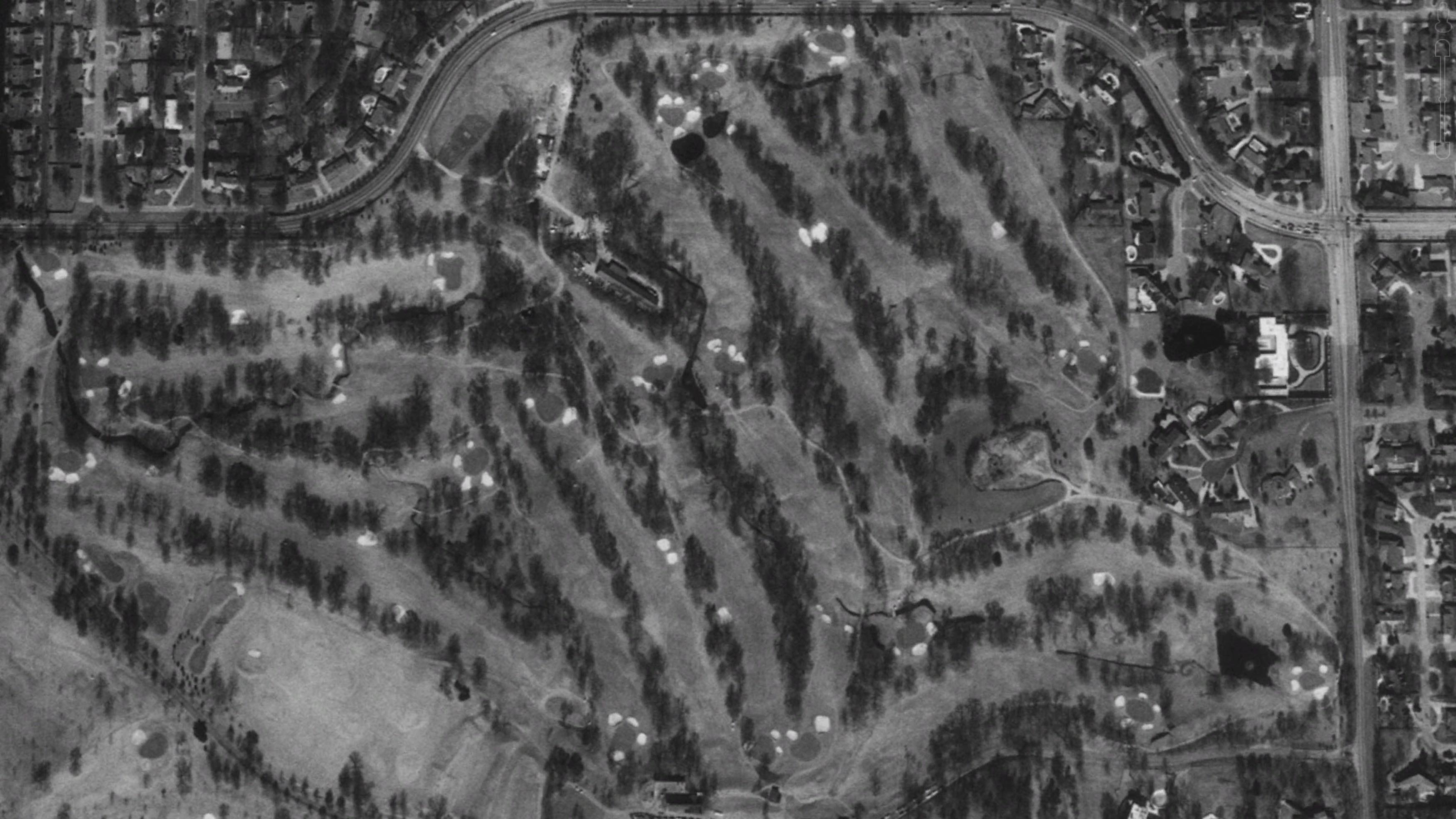
Southern Hills in 1995 (Google Earth)
-
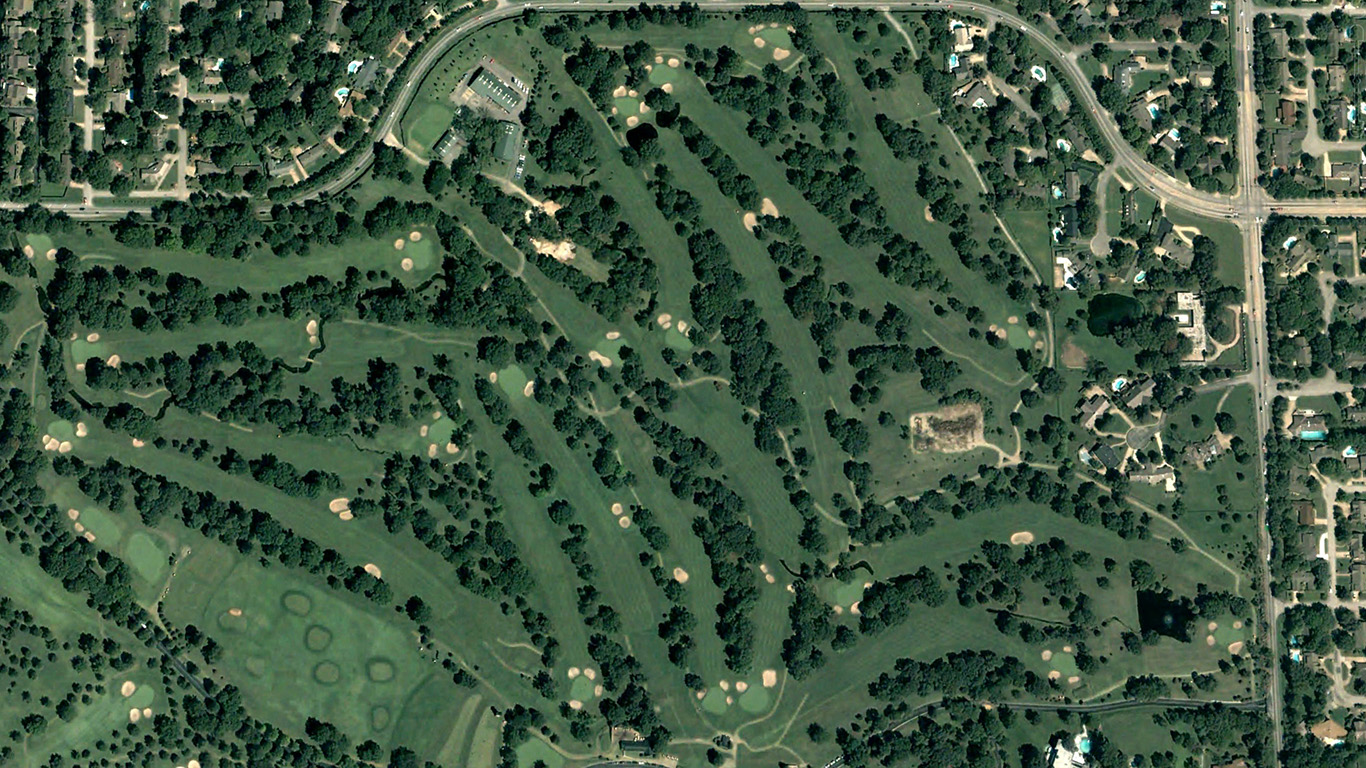
Southern Hills in 2003 (Google Earth)
In the 2000s, however, the tide at Southern Hills shifted. Under the guidance of consulting architect Keith Foster, the club removed trees, widened fairways, reestablished short-grass surrounds, and restored the interiors of Maxwell’s greens. By 2007, when Tiger Woods won the PGA Championship there, Southern Hills looked less tree-cramped and rough-choked than it had at the 2001 U.S. Open. Still, the course had a long way to go before it could claim legitimately to represent Maxwell’s intentions.
Meanwhile, a separate concern arose. Even in archetypal “blast furnace” conditions, with temperatures hovering around 100 degrees, Tiger Woods played the 7,131-yard, par-70 course in eight under. In his second round, he tamed Southern Hills with a masterful 63. He had short irons and wedges into almost every par 4, and he reached the par-5 13th with a 7-iron.
If this was the future of the professional game, how much longer could Southern Hills remain a stringent championship test?
A renovative restoration
When Gil Hanse began consulting with Southern Hills in 2015, he had a tricky balance to strike. Of course, he wanted to sell the members on the brilliance of Perry Maxwell’s 1936 design and to restore as much of it as possible. But he also knew that the club wanted to host major championships and challenge the world’s best golfers. So at all times Hanse had to keep one eye on the past and the other on the future. It wasn’t going to be easy.
But he had a few advantages from the get-go. For one, he was friends with superintendent Russ Myers. Along with Jim Wagner and the Caveman Construction crew, Hanse had worked with Myers on the restoration of the North Course at LACC. Going into the Southern Hills project, Hanse’s team knew they would have a skilled and respected superintendent in their corner.
Also, Southern Hills members were versed in potentially controversial topics like tree removal and bunker reshaping because Keith Foster had already introduced them to those concepts. Foster had, in addition, brought back the interior contouring of Maxwell’s greens, so Hanse and the Cavemen didn’t have to start over there. Aside from creating new pin positions on Nos. 9 and 18, they were free to shift their attention to the edges of the greens.
“Everything we could see from early photographs was the edges of the greens were falling away,” Hanse explains. “They were sloped off as opposed to being receptive. So we stripped away all the edges and restored the edge conditions, which I think [the player has] to be very respectful of now. You get anywhere near the edge and your ball is going off instead of being funneled back on the green.”
Crafting these exterior contours was a task that suited both of Hanse’s main goals. It was undoubtedly restorative: the green complexes now look like Maxwell’s originals. At the same time, their restored edges strengthen the championship defenses of the course. The repelling surrounds at Southern Hills, like those at Pinehurst No. 2, will place a premium on the angle, shape, trajectory, and accuracy of approach shots. They will give the pros fits.
-
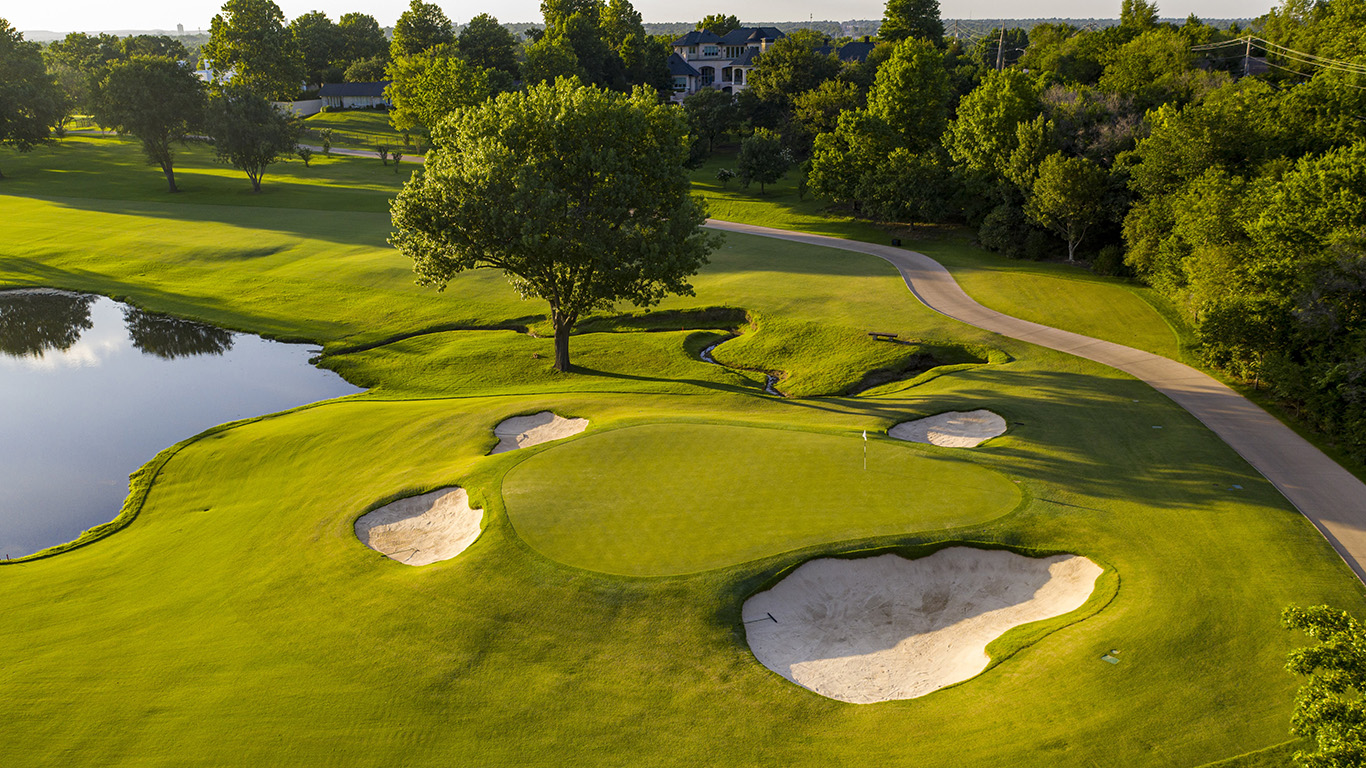
The 11th green at Southern Hills
-
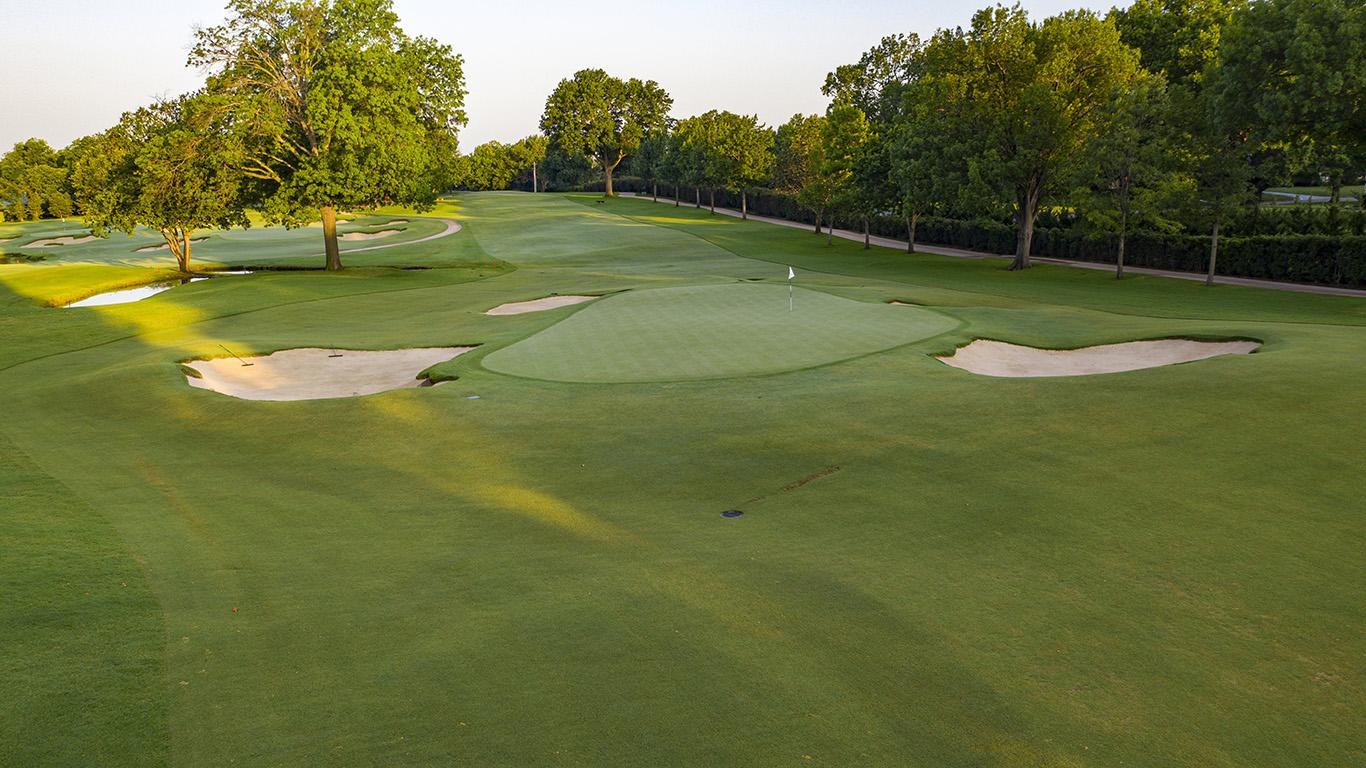
The 14th green at Southern Hills
-
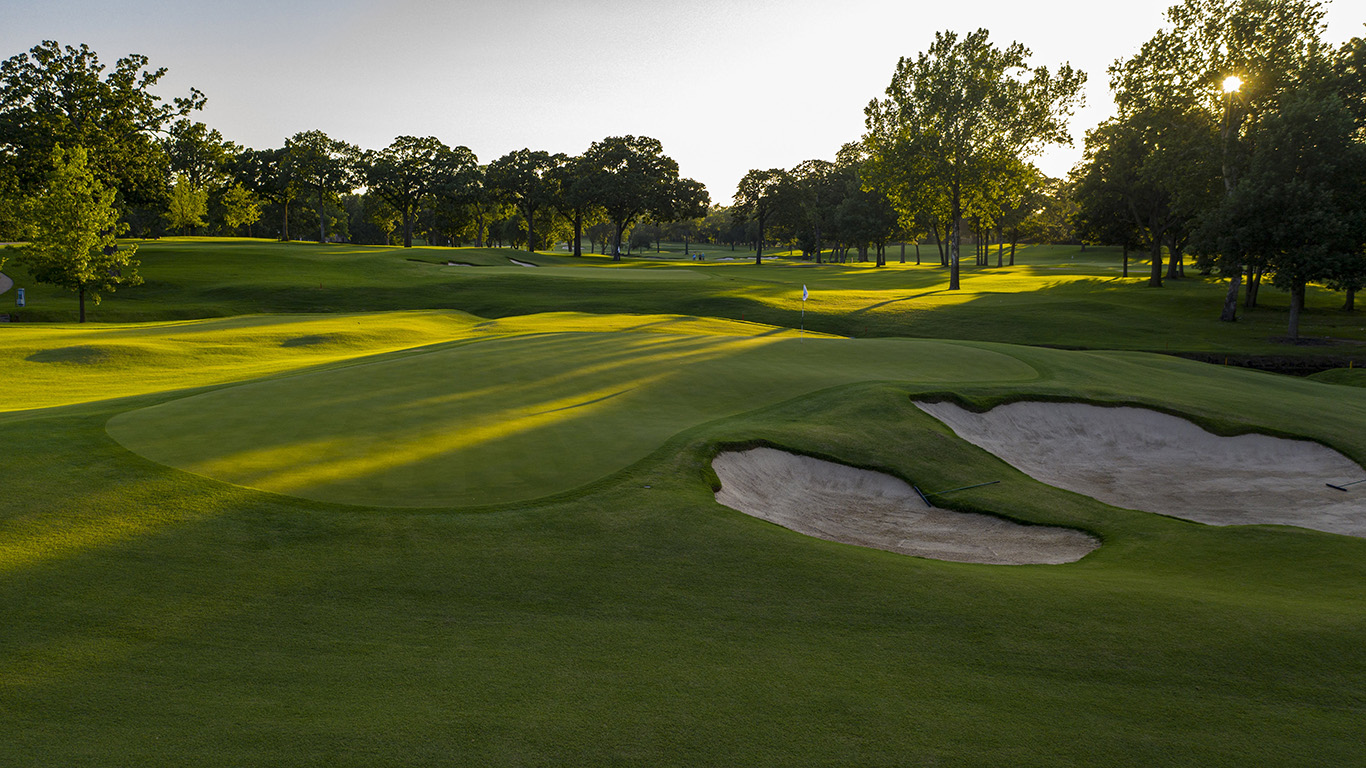
The 17th green at Southern Hills
-
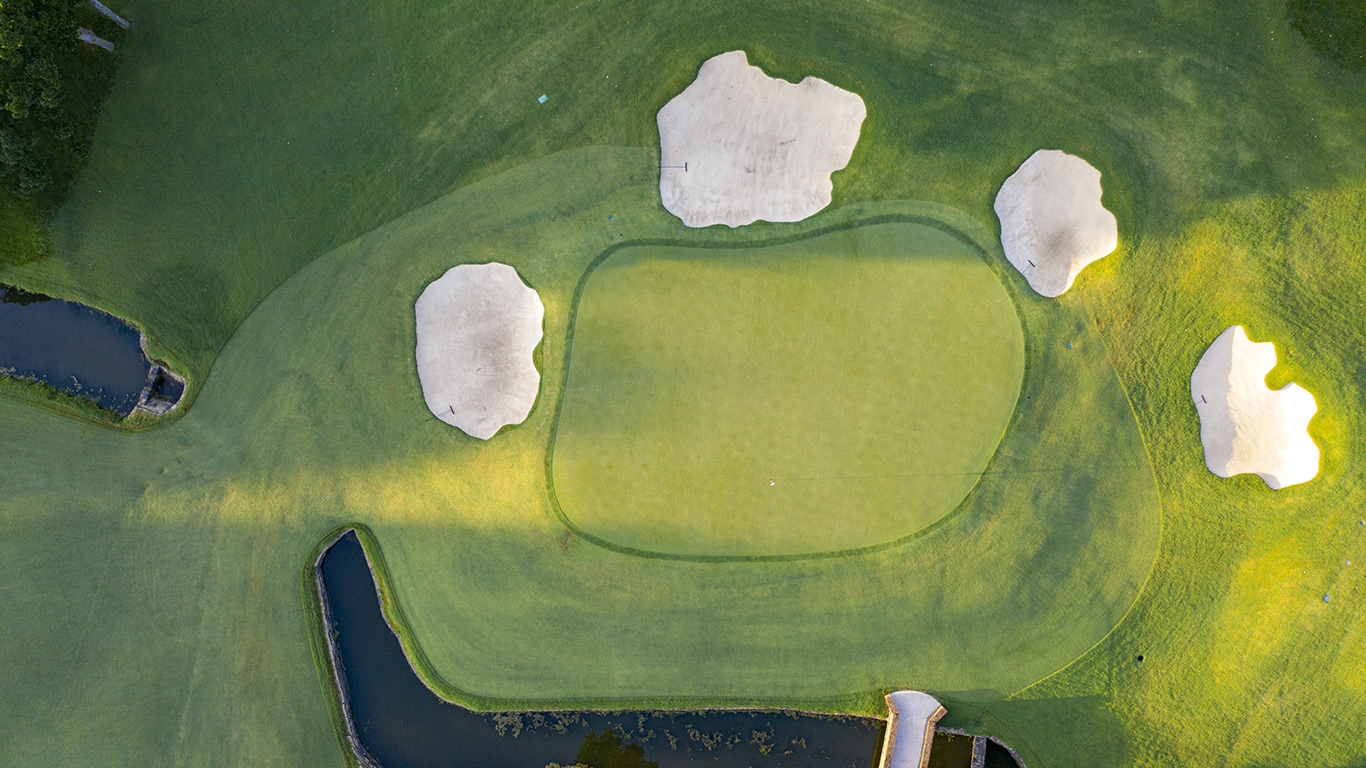
The 12th green at Southern Hills
In other aspects of his work, however, Hanse had to locate a happy medium between Golden Age restoration and 21st-century championship renovation. Overall, he estimates that “it was probably about 75 to 80 percent restoration and 20 to 25 percent renovation.”
The original bunkers at Southern Hills, for instance, were ragged creations with occasional islands of tall, wild grass. Knowing that the membership wouldn’t be crazy about a full return to that style, Hanse went for “a blending of a more manicured and an eroded look.” He found inspiration in Coore & Crenshaw’s work at another Maxwell design, Old Town Club in North Carolina. “We looked at that style and thought, ‘Yeah, that could fit at Southern Hills.’” Today, the finished bunkers both follow Maxwell’s irregular lines and have settled, polished edges.
-
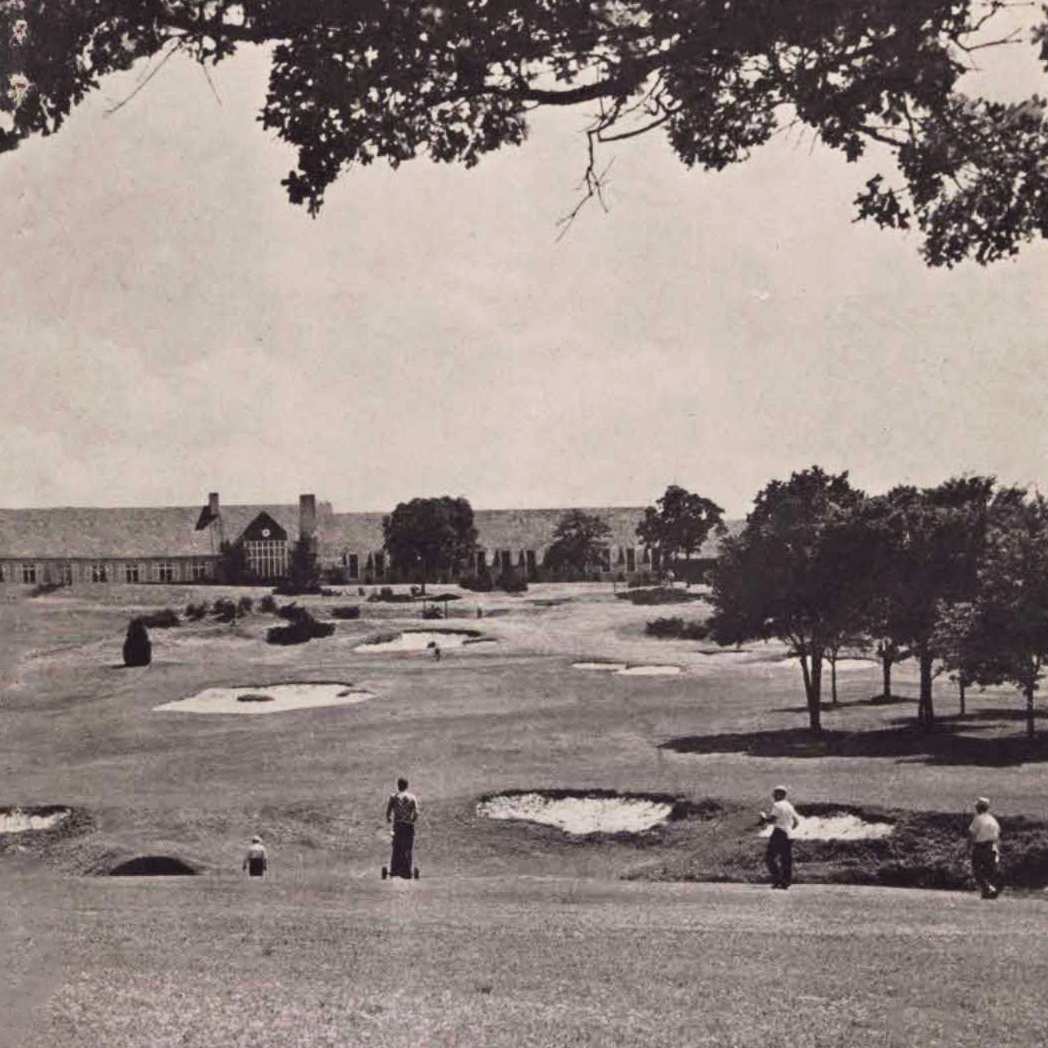
The 18th hole at Southern Hills in the 1930s
-
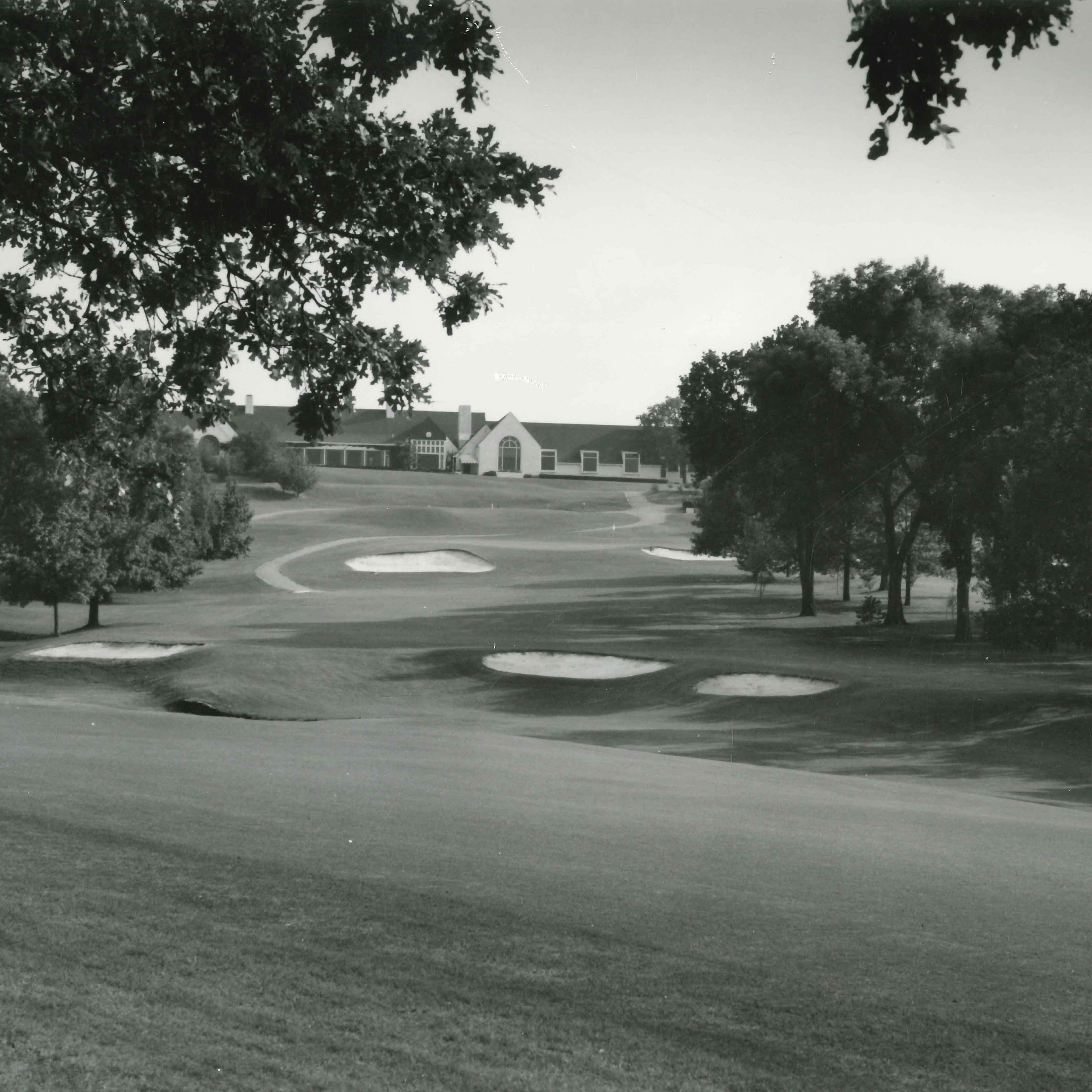
The 18th hole at Southern Hills in the 1980s
-
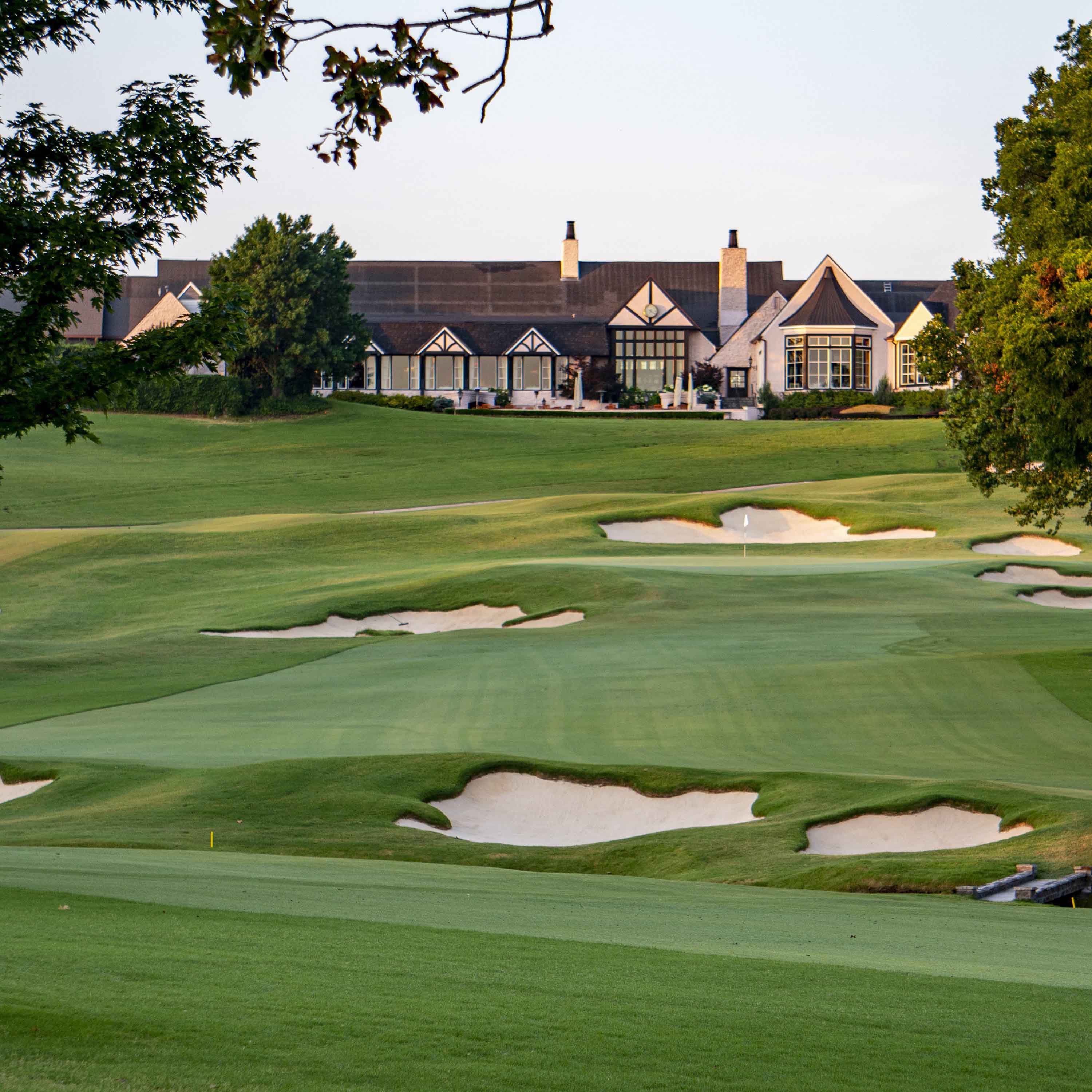
The 18th hole at Southern Hills today
Other compromises between 1936 and 2019 included shifting the locations (while preserving the contours) of the 6th and 14th greens—to make way for a maintenance road and to steer clear of out-of-bounds, respectively. Also, while Hanse was able to restore the creeks that ran across the 10th and 17th fairways, he could not bring back the ruggedness and seasonal dryness they had in Maxwell’s day. Between modern irrigation methods and the growth of the surrounding neighborhoods, the creek system at Southern Hills receives an amount of run-off unheard of in the 1930s.
Perhaps the most new-fashioned aspect of Southern Hills lies underground. During the restoration, the club installed 200,000 feet of tubing beneath the greens for heating and cooling. This state-of-the-art hydronics system will give Russ Myers precise control over the subsurface temperatures of the bentgrass putting surfaces. It is an innovation that Perry Maxwell couldn’t have imagined, and one that traditionalists may decry as an extravagance.
According to Hanse, though, this infrastructure is key to preserving Southern Hills’ ability to host championships. If you want to make the top golfers think, he says, “It’s all about the greens.” To be more specific, it’s all about firm greens, and that is where hydronics comes in.
“Those players work so hard on their games, and technology is now conspiring with them to maximize their swings,” Hanse explains. “What they’re looking for is a predictable result on every single shot. Well, if a green’s firm, you’re not sure if it’s going to bounce and check, bounce twice and check, not check. There’s that thing you have a much harder time controlling. If that’s part of the test, it emphasizes hitting it in the fairway. You hit it in the rough and you have firm greens, you’re done. So the ability to move water through the greens quicker and to provide the opportunity for the superintendent to get the greens firmer and faster is really critical for clubs that aspire to host championships.”
At Southern Hills, elite players won’t be intimidated by the length of the course or the size of the fairways. They may not even worry much about the bunkers. But when they see Southern Hills’ combination of undulating fairways and firm, Maxwellian greens, their blood pressure may rise a bit. No one, not even a pro, feels comfortable hitting from a sidehill lie to a crowned green surrounded by hazards and short grass.
Two Maxwell-Hanse collaborations
In fine-tuning the designs of individual holes, Hanse had to make a number of complicated judgment calls. Generally he erred on the side of restoring Perry Maxwell’s features while adding back tees and moving a few fairway bunkers downrange. In a couple of cases, however, Hanse departed more significantly from Maxwell’s concepts.
The 1st hole at Southern Hills is one of the most dramatic openers anywhere. From a tee in the shadow of the clubhouse, players launch their opening drives off a hill, straight at the Tulsa skyline. The hole moves gently to the left, riding the right-to-left slope of the terrain. The green sits naturally on the land as well, running away and to the left. It is guarded by bunkers back-left and short-right. Overall, given the green’s tilt and orientation, you are better off hitting your approach from the left half of the fairway, especially when there is a right-hand pin. From there, the bunkers are no longer in your line, and the green does not fall directly away from you.
Originally, the hole had no fairway bunkers. In 1957, to add difficulty for the U.S. Open, Robert Trent Jones added a pair of bunkers right of the fairway, on the outside of the dogleg. In retrospect, they didn’t make much sense there. If you risked going in them, your only reward was a bad angle.
For a pure restoration, Hanse could have taken the bunkers out, but in a way, that would have been less historically reverent. “Every championship that has ever been played there,” he explains, “there have been bunkers in the fairway.” So instead he encouraged the club to relocate the bunkers to the left side, where they now serve a classic strategic purpose. The closer you play to them, the better your angle into the green. As it stands, the 1st hole at Southern Hills may not be a Maxwell original, but it tells a coherent strategic story.

Before/after of the 1st hole at Southern Hills, courtesy of the club. Photo credits: Clyde Chrisman and Mike Klemme
-
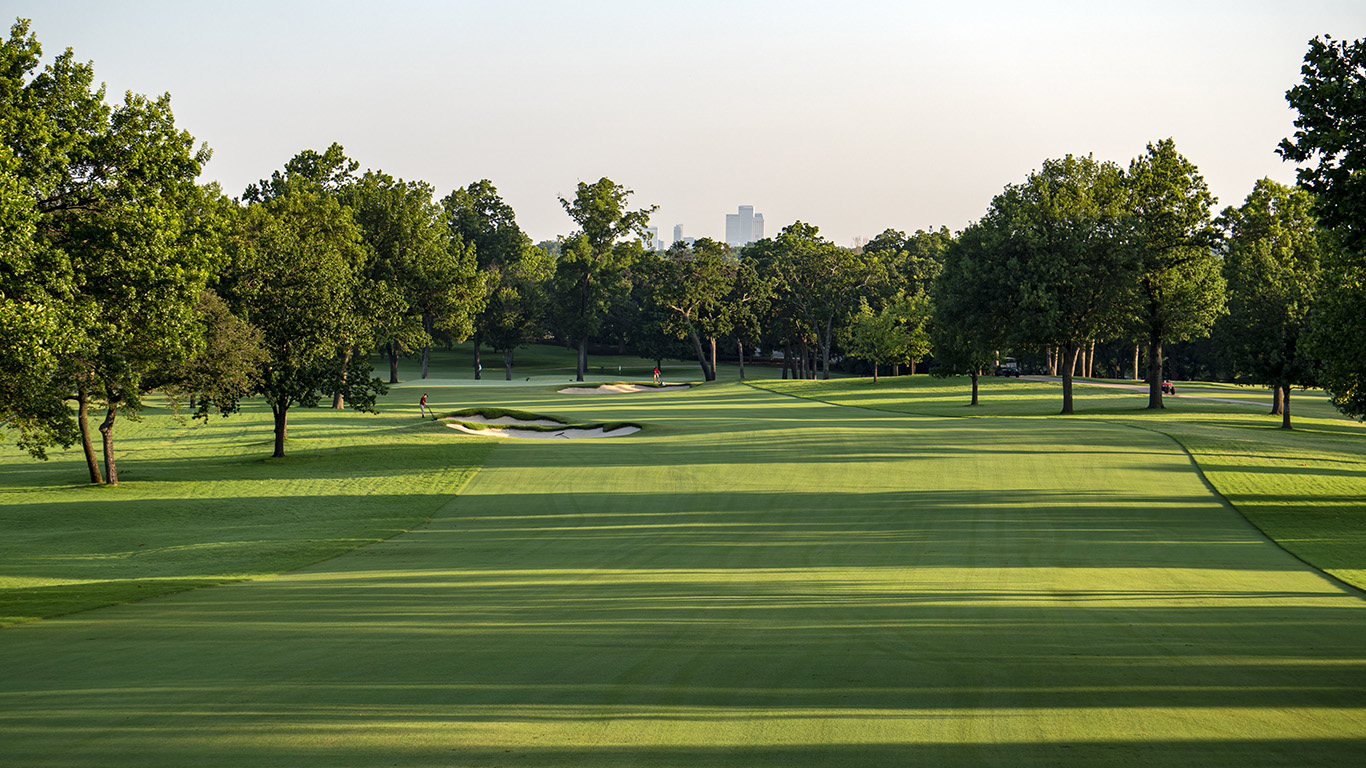
Down the 1st fairway at Southern Hills
-
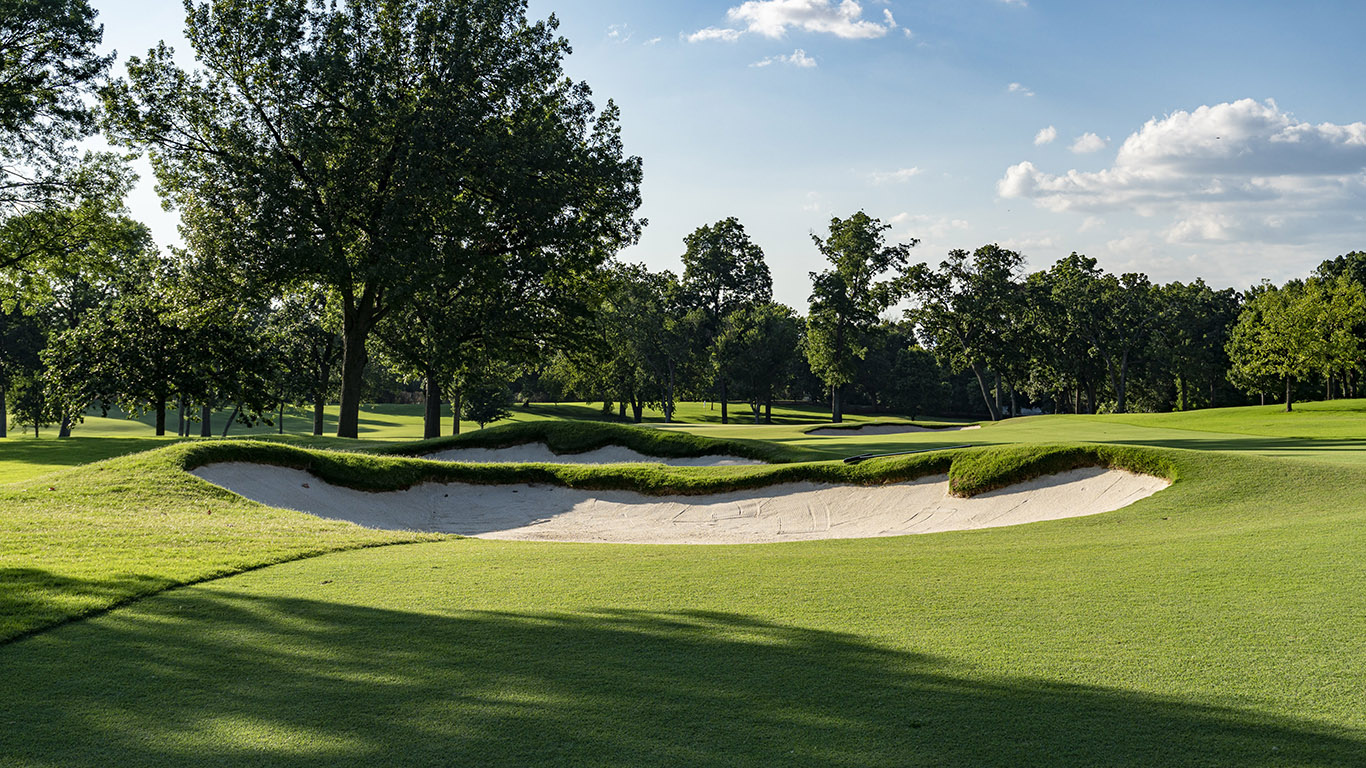
Toward the 1st green from the fairway bunkers at Southern Hills
-
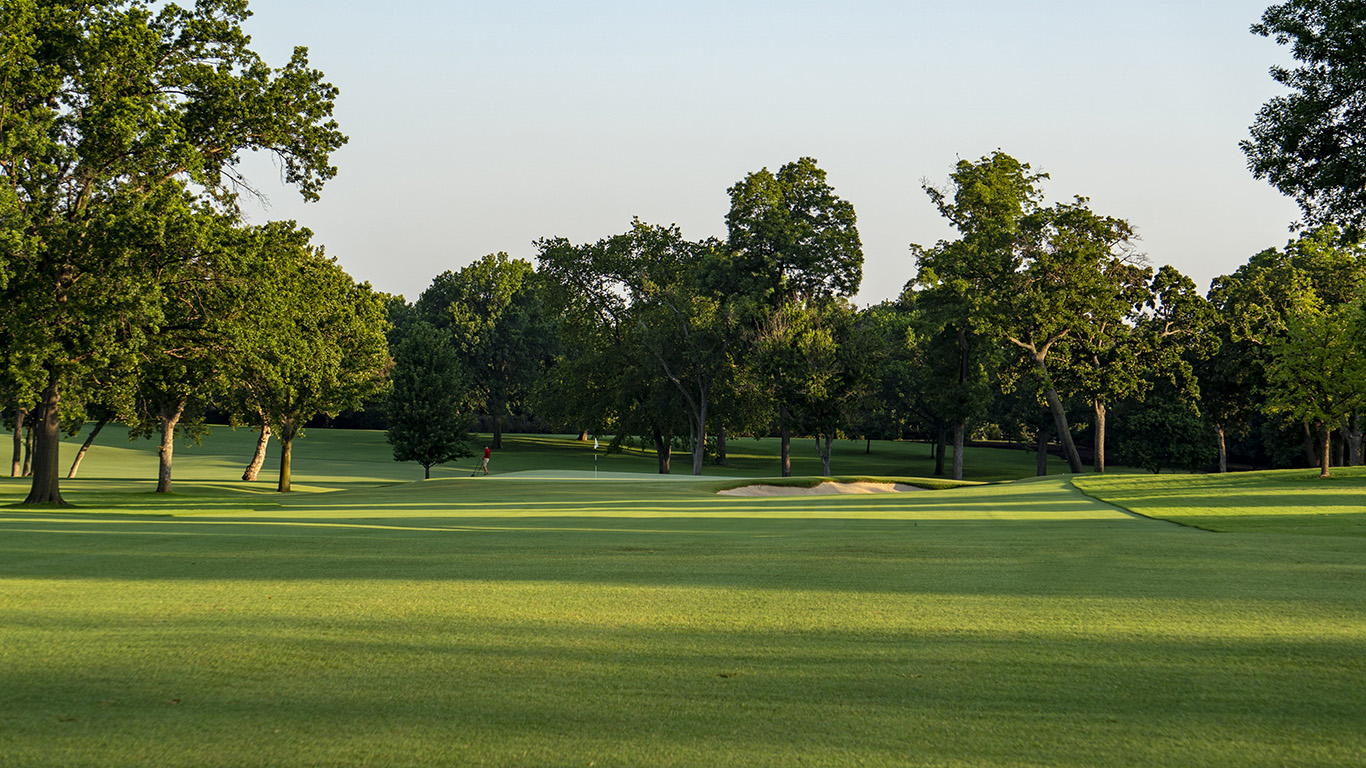
The approach to the 1st green at Southern Hills
-
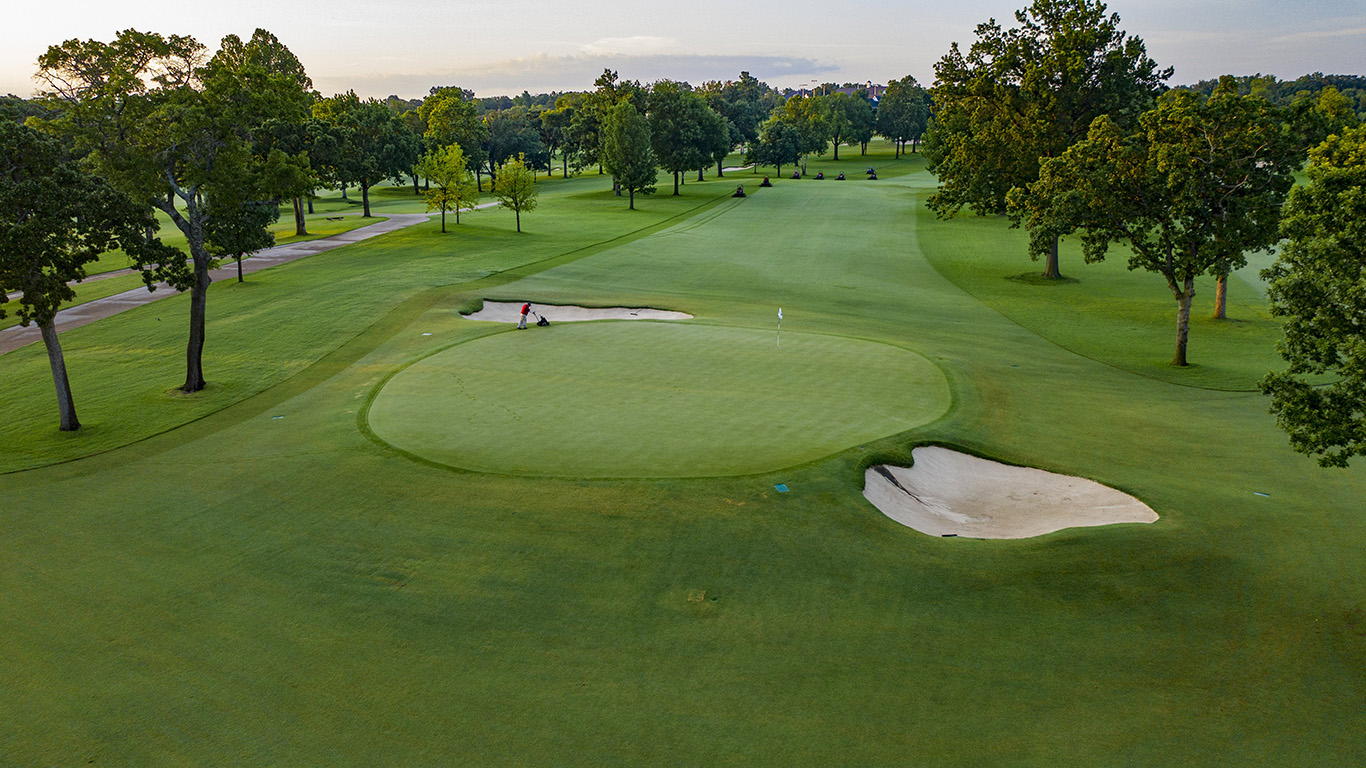
Behind the 1st green at Southern Hills
On No. 7, Hanse dealt with a similar set of quandaries. In 1936, the hole turned uphill and sharply to the left, to a green hard by a boundary. By the 1960s, the club had moved the green to the right and down the hill, making the hole a straightaway par 4 of about 380 yards. A hardline restorationist might have insisted on recovering the old design, but Hanse demurred. On the other side of the property line that abutted Maxwell’s green, there was now a busy urban thoroughfare. “In this day and age,” Hanse says, “as litigious a society as we live in, there are very few golf architects who are going to move a green closer to a boundary.”
Besides, he liked another option: pushing the green back about 40 yards and pressing it against a creek that runs up the right side of the hole. The new 7th is still basically straight, but the water affects play on both the drive and the approach. If you hedge left off the tee, to the high, safe half of the fairway, you face a scary second shot. The sidehill lie urges your approach to the right, toward the creek. Furthermore, since the green slopes left-to-right, it calls for a shot shape opposite to the lie. If, however, you challenge the creek on your drive, the sidehill lie is less severe, the creek not as much in your line, and the cant of the green not as unfriendly to your angle.

Before/after of the 7th hole at Southern Hills, courtesy of the club. Photo credits: Clyde Chrisman and Mike Klemme
-
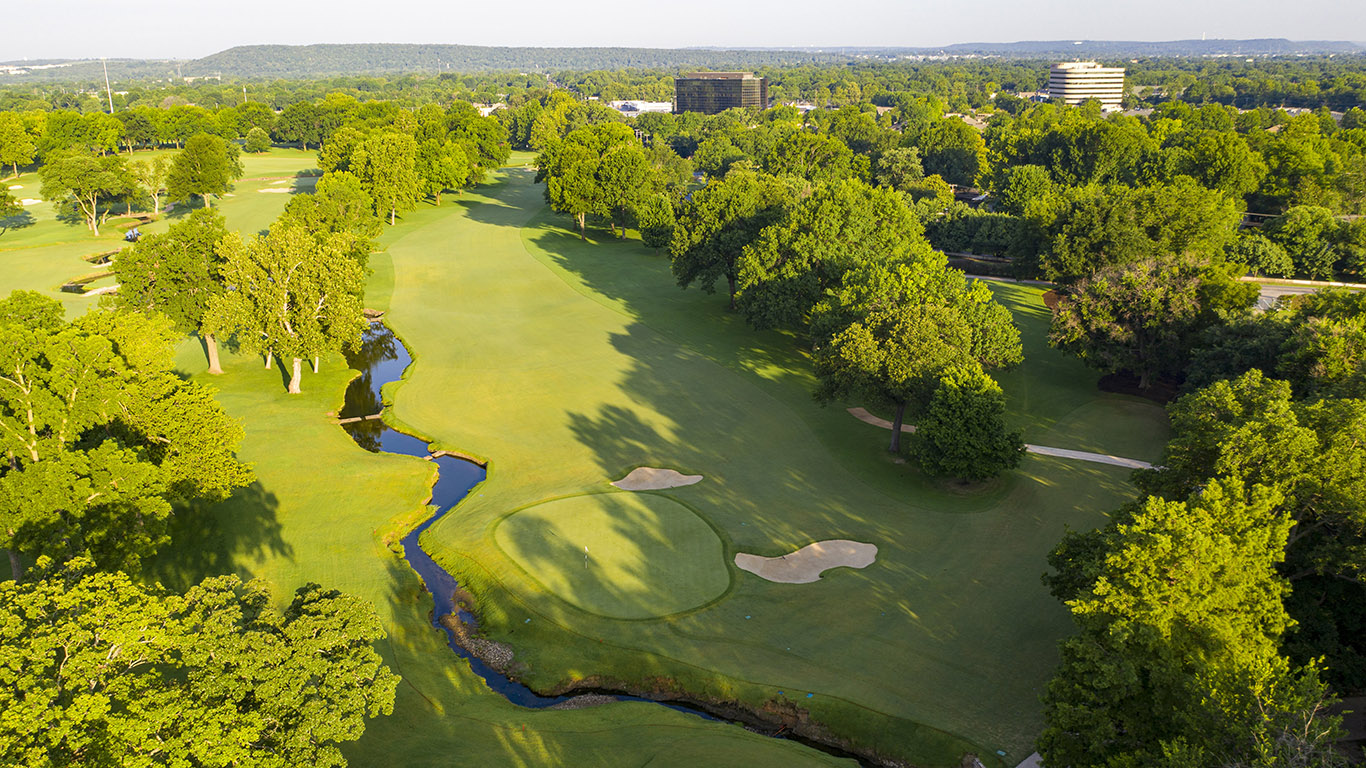
High above the 7th hole at Southern Hills
-
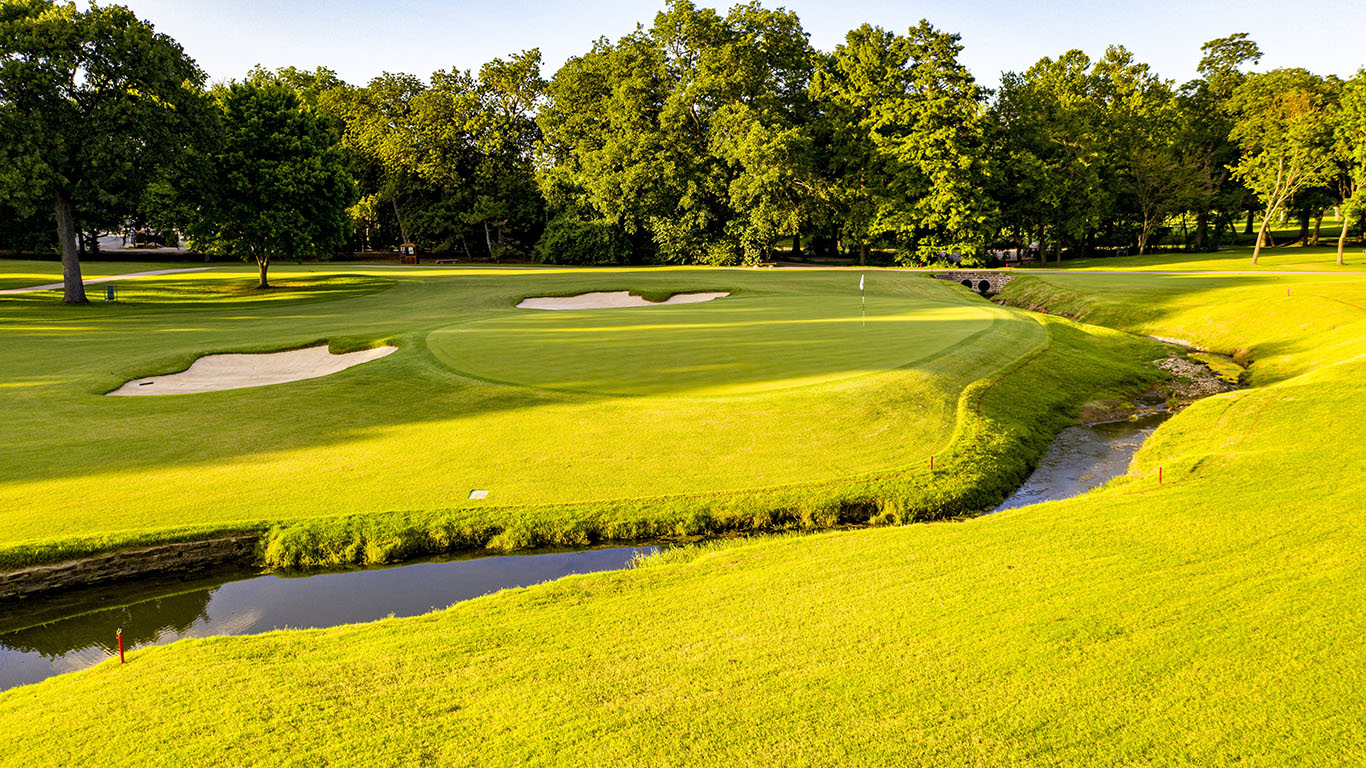
To the right of the 7th green at Southern Hills
-
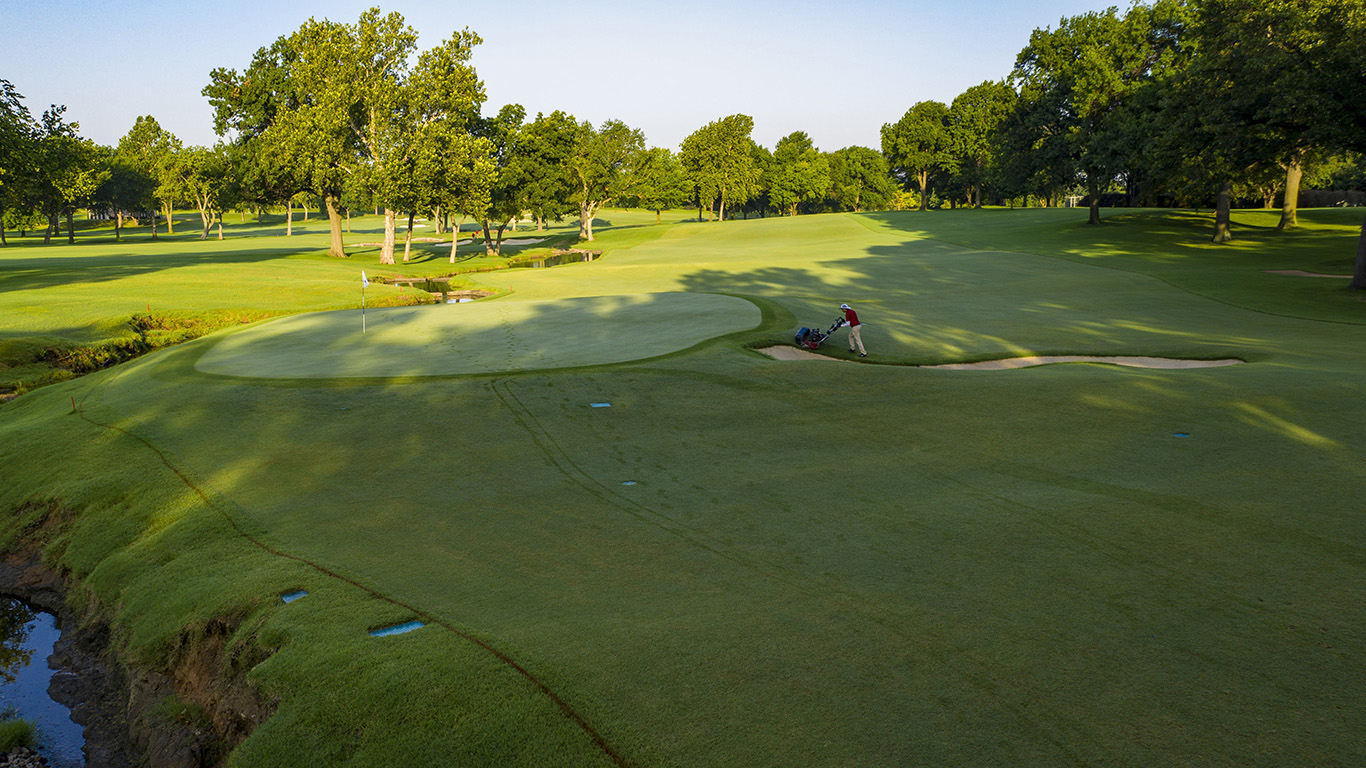
Behind the 7th green at Southern Hills
For Hanse, a key advantage of the new green site was the length it added to the hole. Rather than a drive and a pitch for longer players, the 7th is now a full-blooded championship par 4 of 440-some yards. “What had happened before with the old green,” Hanse explains, “was that very, very few players would hit driver off that tee because all they needed to do was hit a hybrid or a 3-wood or a 5-wood up to the top of the hill, and they had a short iron into the green. There’s no point in challenging anything [to the right]. Now you can still hit that shot, but you’re going to have a 200-yard shot into the green. Good luck from that angle.”
Here, as elsewhere at Southern Hills, Hanse had to keep in mind how far today’s best players hit the ball, and how easily that power can nullify the strategy of a hole.
Southern Hills in full
When one walks the new Southern Hills, the various details of Hanse’s negotiations between restoration and renovation, between the Golden Age and the modern championship era, tend to melt away. As a full work, a narrative in 18 holes, it is a masterpiece. Recent iterations of the course have concealed this fact, but two decades of improvements by Foster, Hanse, and the grounds crew have brought the true character of Perry Maxwell’s design to light.
Like many of America’s best championship venues (Augusta National, Pebble Beach, Shinnecock Hills, etc.), Southern Hills marries a large-scale site with an intimate routing. The clubhouse stands on a grand hill at the southern end of the property, and Maxwell’s holes do not shy away from the elevation change. Nos. 1, 5, and 10 vault off the hill, and Nos. 4, 9, and 18 climb up it. In the creek-laced valley that contains most of the course, striking landforms define the field of play.
-
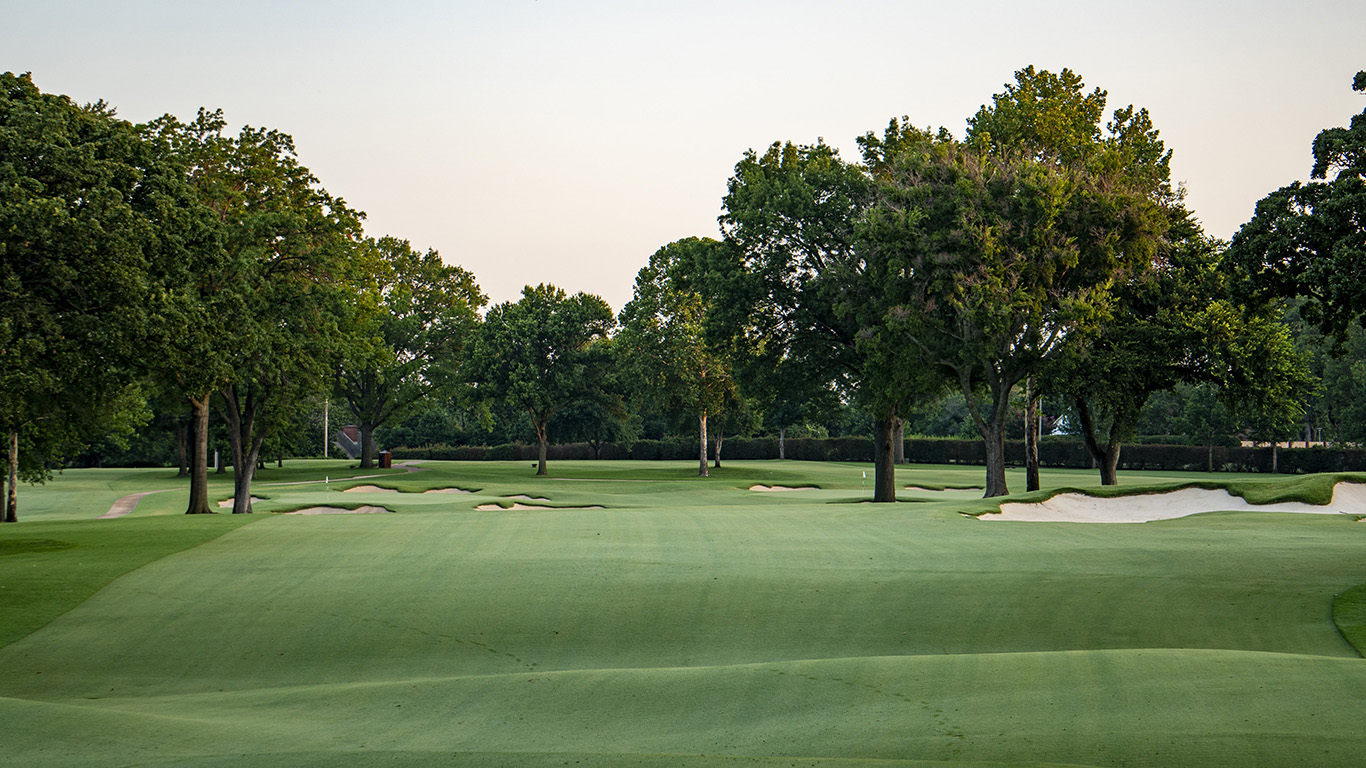
Gully running through the 13th fairway at Southern Hills
-
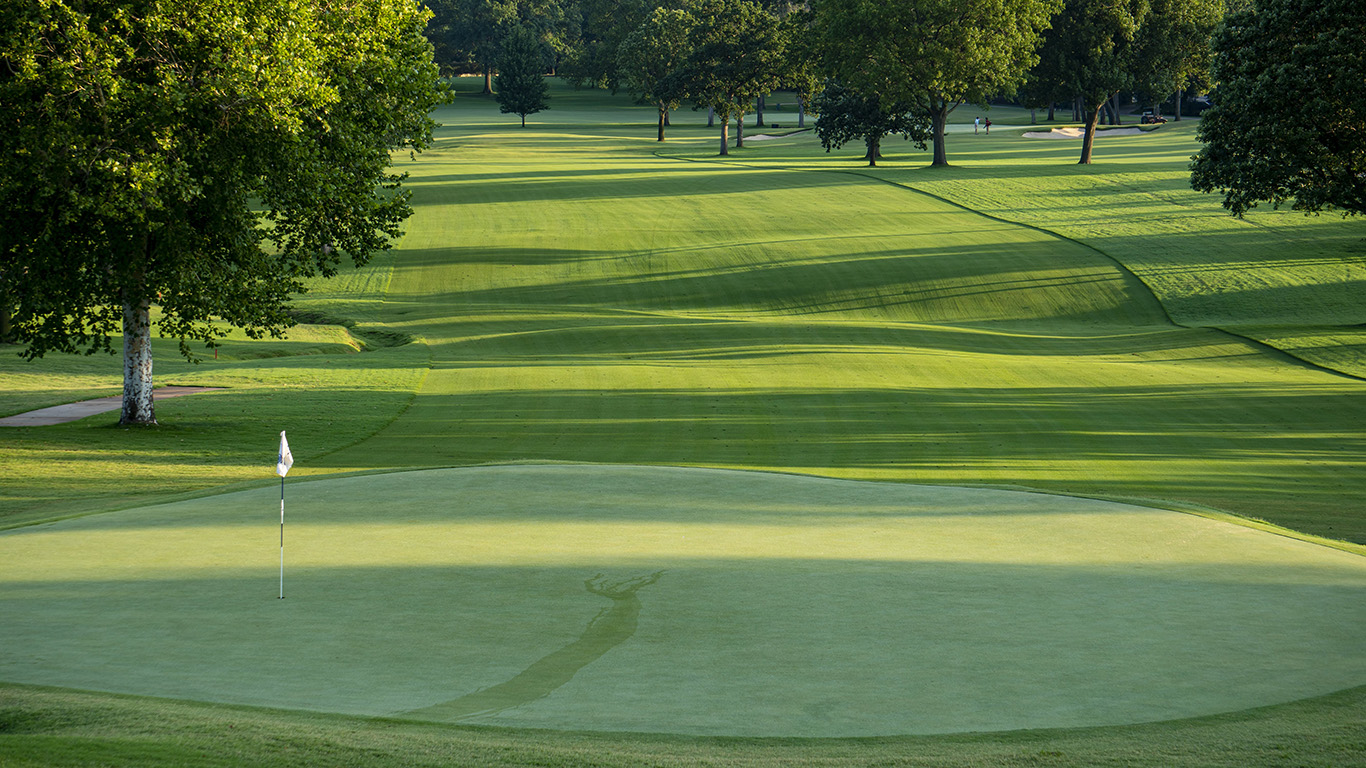
Looking back from the 4th green at Southern Hills
-
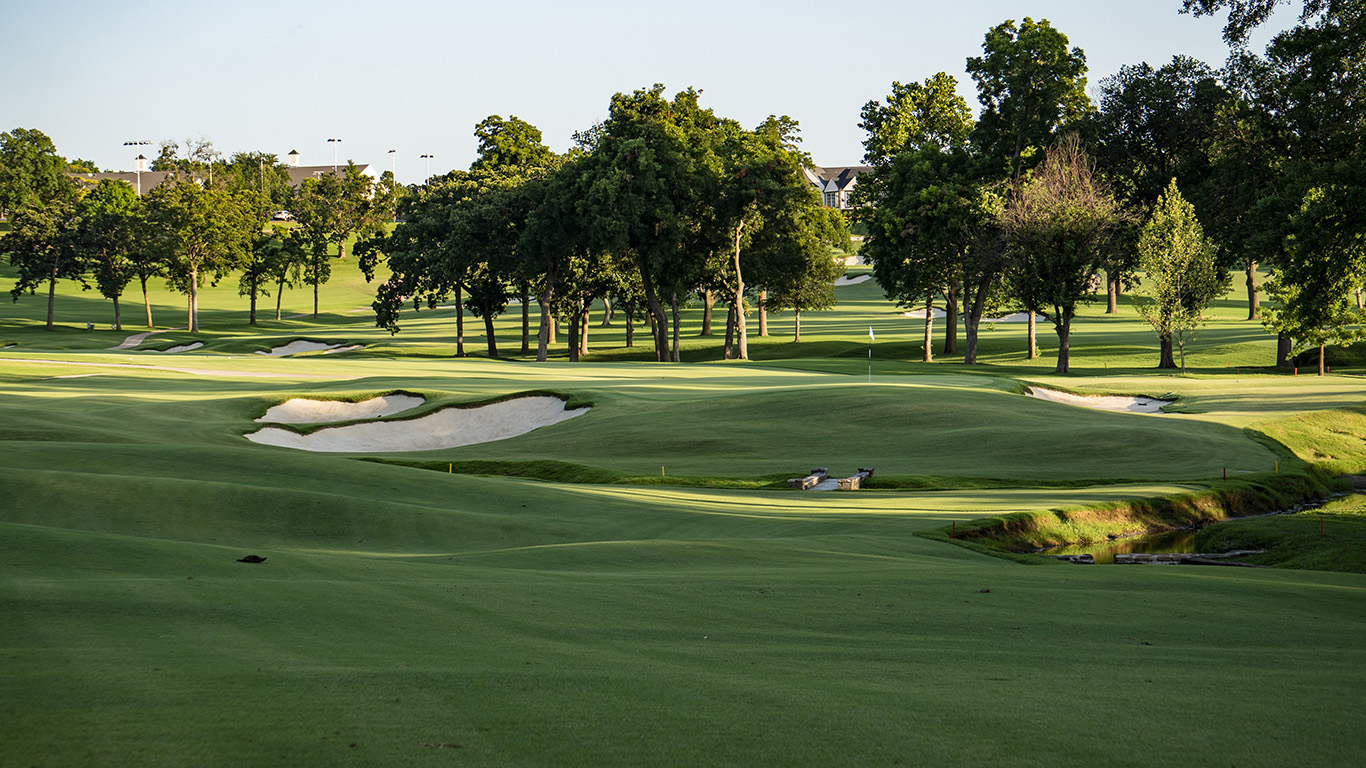
The approach to the 17th green at Southern Hills
-
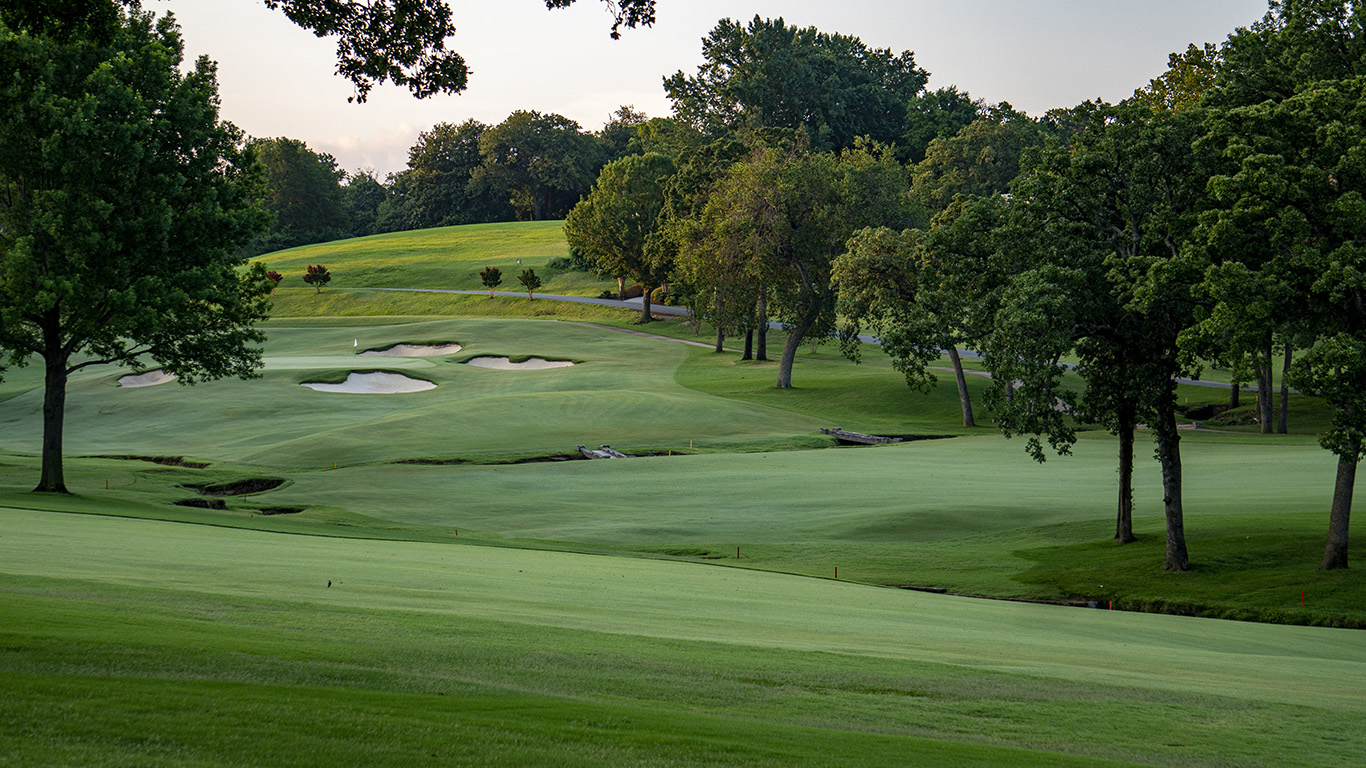
Across the 12th fairway to the 10th green at Southern Hills
But the course doesn’t just highlight the scale of the topography; it also creates a sense of intimacy by returning over and over to certain locations. The routing of Southern Hills revolves around two axes. The first is on the clubhouse hill, where Maxwell placed (from east to west) the 5th tee, 4th green, 1st tee, 9th green, 18th green, and 10th tee. The second axis is in the heart of the property, along the subtle ridges above a mostly dry and grassed-over gully. Here you will find the 3rd green, 4th tee, 1st green, 9th tee, 8th green, 18th tee, and 17th green. The gully then cuts mischievously across the landing zones of the 13th and 16th fairways.
-
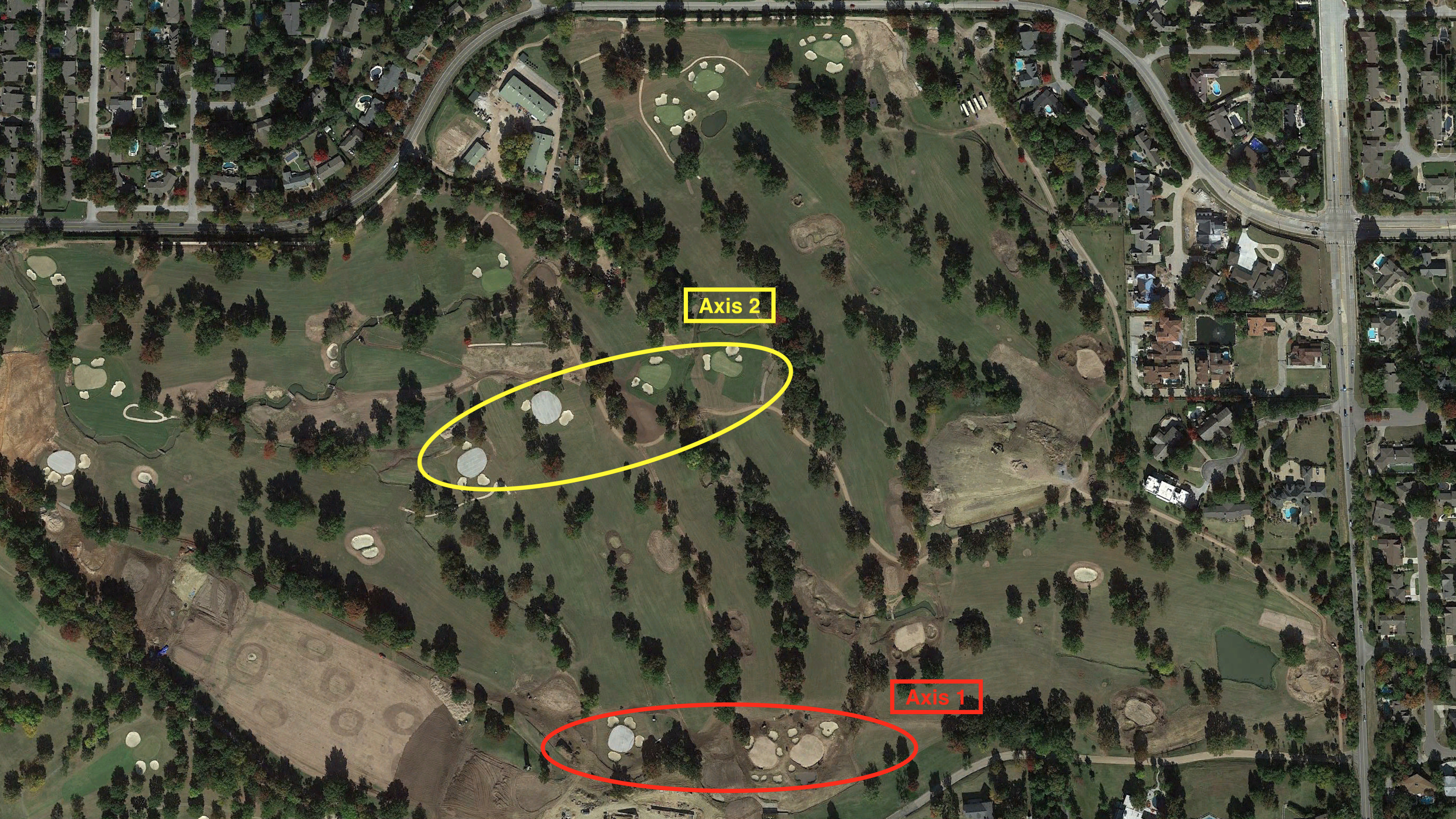
A mid-restoration aerial view of Southern Hills (Google Earth)
-
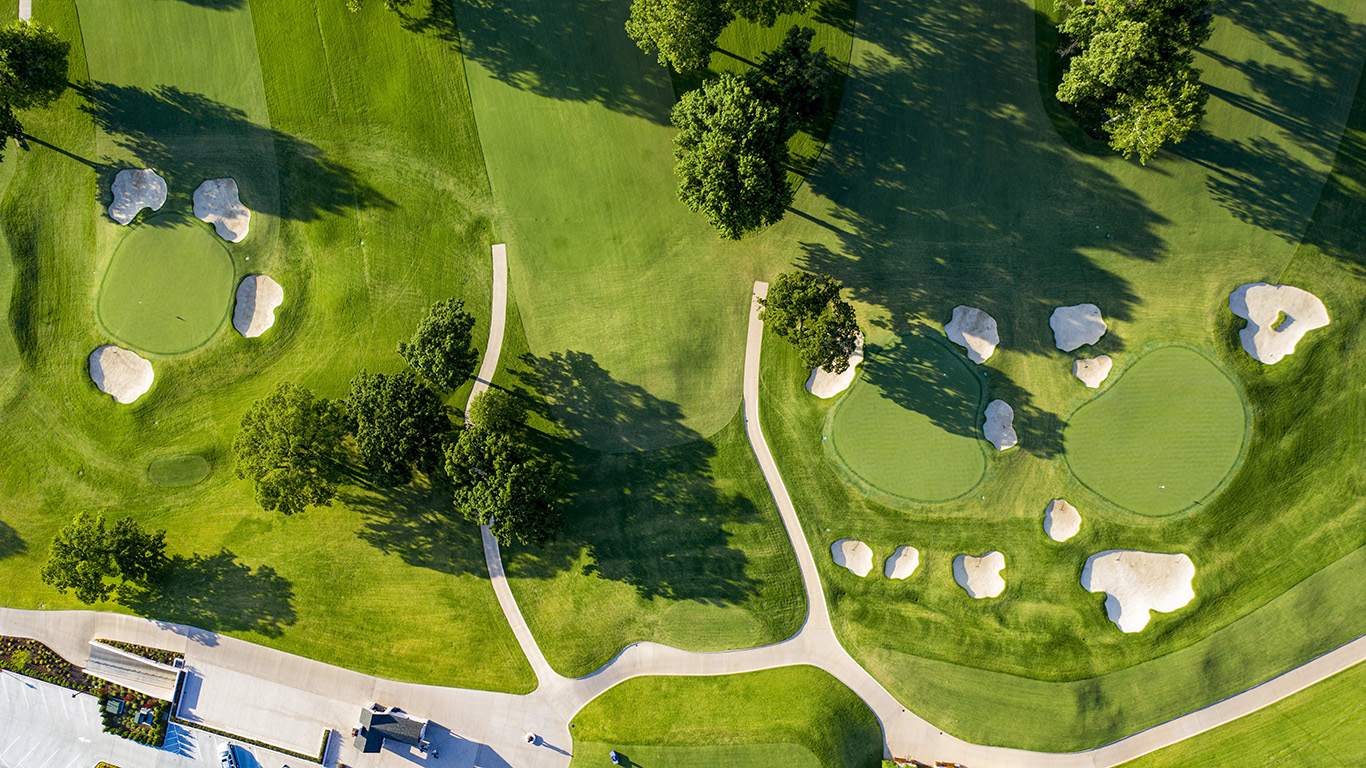
From left to right: 4th green, 1st tee, 9th green, 18th green at Southern Hills
-
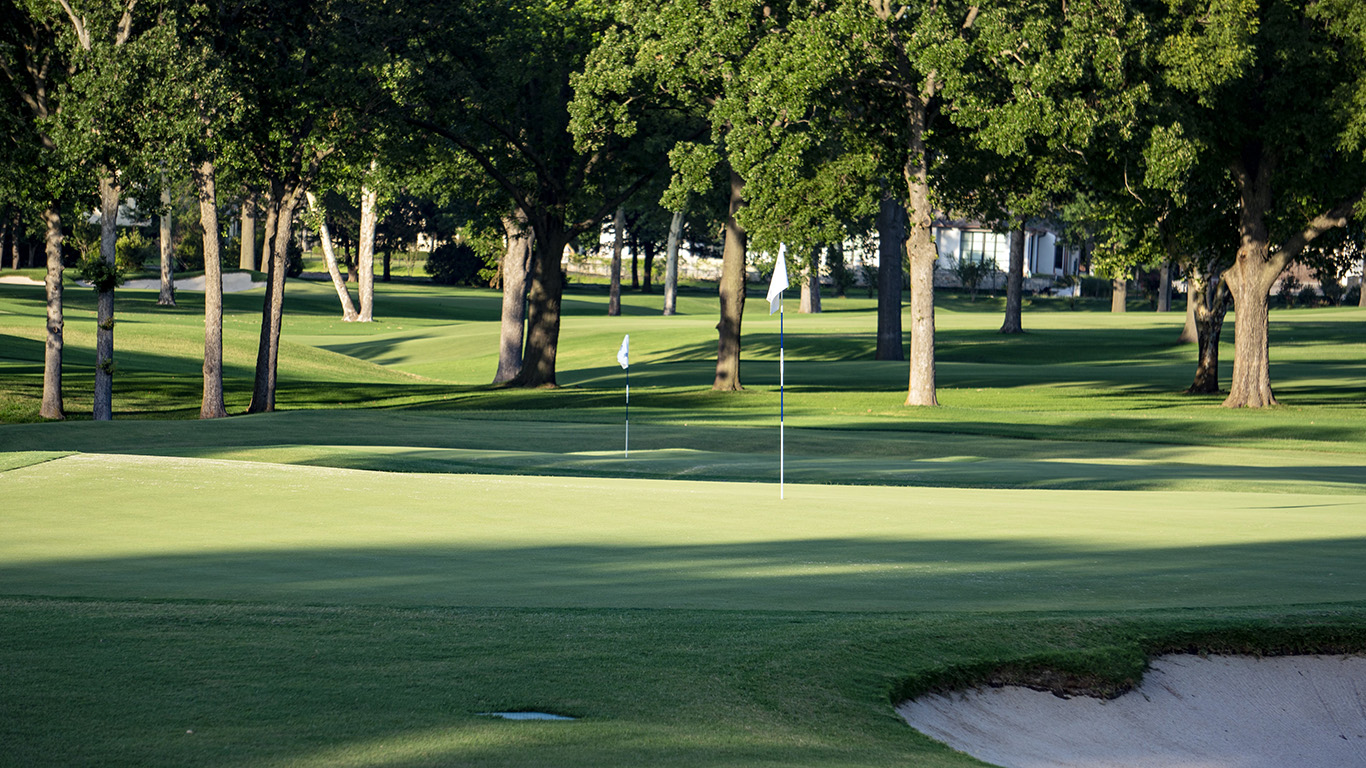
8th green (foreground) and 17th green (mid-ground) at Southern Hills, with the gully running through the 13th and 16th fairways in the background
Maxwell must have seen a number of benefits to this type of routing. First, it was economical. On just those two axes, he put six tees and seven greens in locations that drained naturally and could be made functional with little earthmoving. Second, the routing of Southern Hills takes full advantage of some of the site’s most compelling features, using them to create intrigue on multiple holes and fixing them in the golfer’s memory. Third, it allows for easy spectating on a property that might have otherwise been tough to navigate. During a tournament, any fan who camps out by the clubhouse or the 1st green will see a lot of action.
This pairing of an intimate layout with dramatic terrain has been brought into relief by the recent restoration work, particularly by the thinning of trees and the expansion of short-grass areas. Now, wherever you are on the course, you can see across multiple holes, and you can perceive both the dimensions of the landforms and the logic of Maxwell’s routing. These virtues are no longer hidden under rough or blocked by trees.
Consider again the 1st hole, which connects the first axis of Southern Hills to the second. Twenty years ago, the fairway moved between two dense stands of trees. Now, as you walk down into the valley, there are still trees, but in the gaps between them, the rest of the course reveals itself.
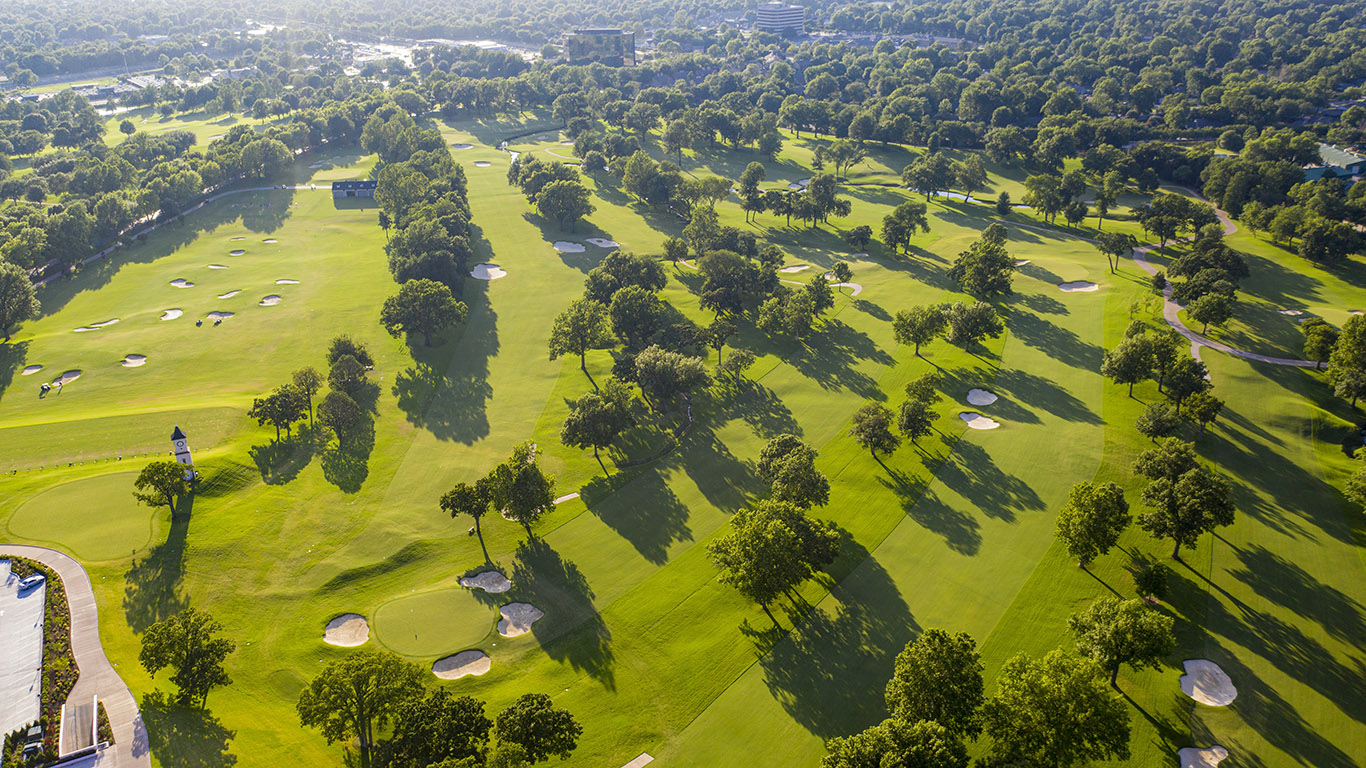
An overhead view of the front nine at Southern Hills, with the 1st hole on the right and the driving range on the left
Redefining championship golf
For many golf architecture geeks, “championship course” has become an expletive—and for good reason. The term evokes an artless, punitive style of design that seeks to humble professionals while making no provisions for regular amateurs.
These days, the values of playability, fun, and quirk are back in fashion, as are the courses of the Golden Age. Hundreds of well-known clubs have hired architects to turn back the clock. Meanwhile, competitive golf seems to be racing in the other direction, embracing innovations in technology, training, and instruction that have inflated the proportions of the game. This has created a mismatch: many of the best golf courses no longer fit the best golfers.
Yet championships must be held, and courses must be found to host them. Some of these turn out to be championship courses in the familiar sense, boasting 500-yard par 4s, tight corridors, severe side hazards, and forced carries that eliminate all but the longest and straightest drivers of the ball from contention. A handful of venues, however, have strived for something more interesting. They have used firm turf and rejective green contouring as defenses against the top players, but they have kept enough width and short grass to make things enjoyable for the average Joes. These courses, the Shinnecocks and Portrushes, seek to bring together two increasingly disparate classes of golfers.
This is what Southern Hills hopes to do. With his restoration, Gil Hanse tried to build a bridge between Golden Age architecture and 21st-century championship golf. He saw that he could not deliver pure Perry Maxwell, so he produced a hybrid both classic and modern, both grand and approachable, both challenging for great players and navigable for ordinary ones. These are delicate balances. Only time—and future championships—will tell if Southern Hills can maintain them.


 by
by 
